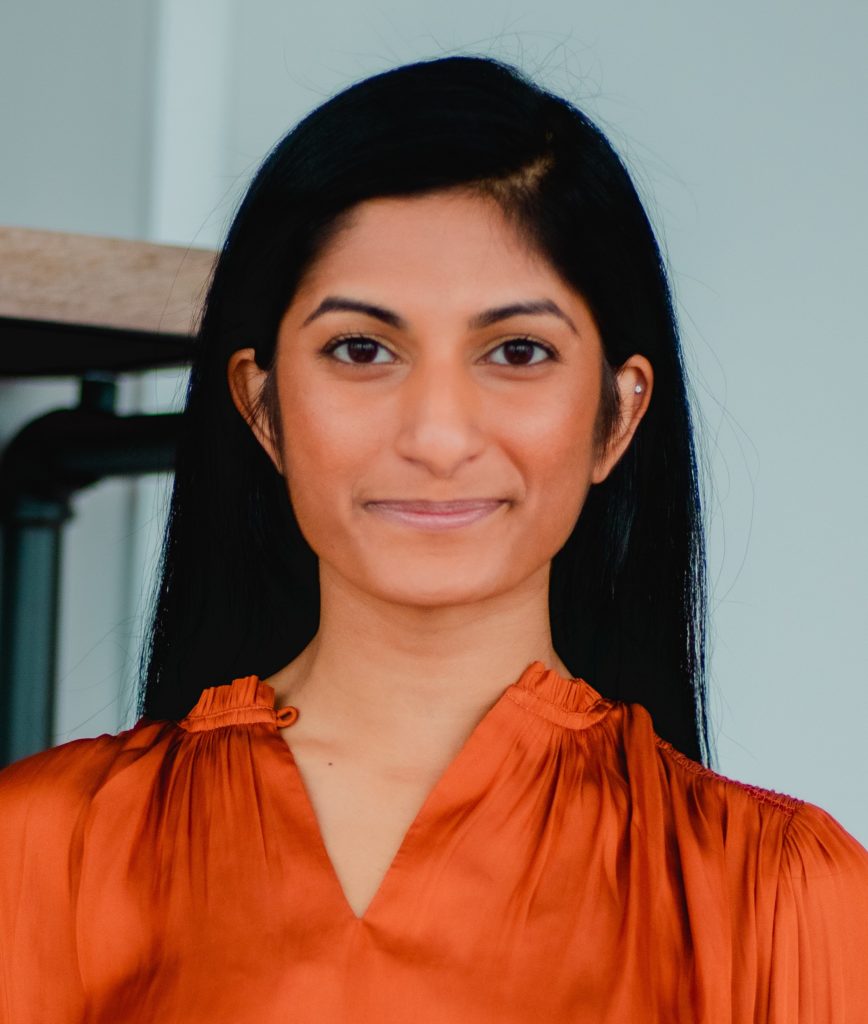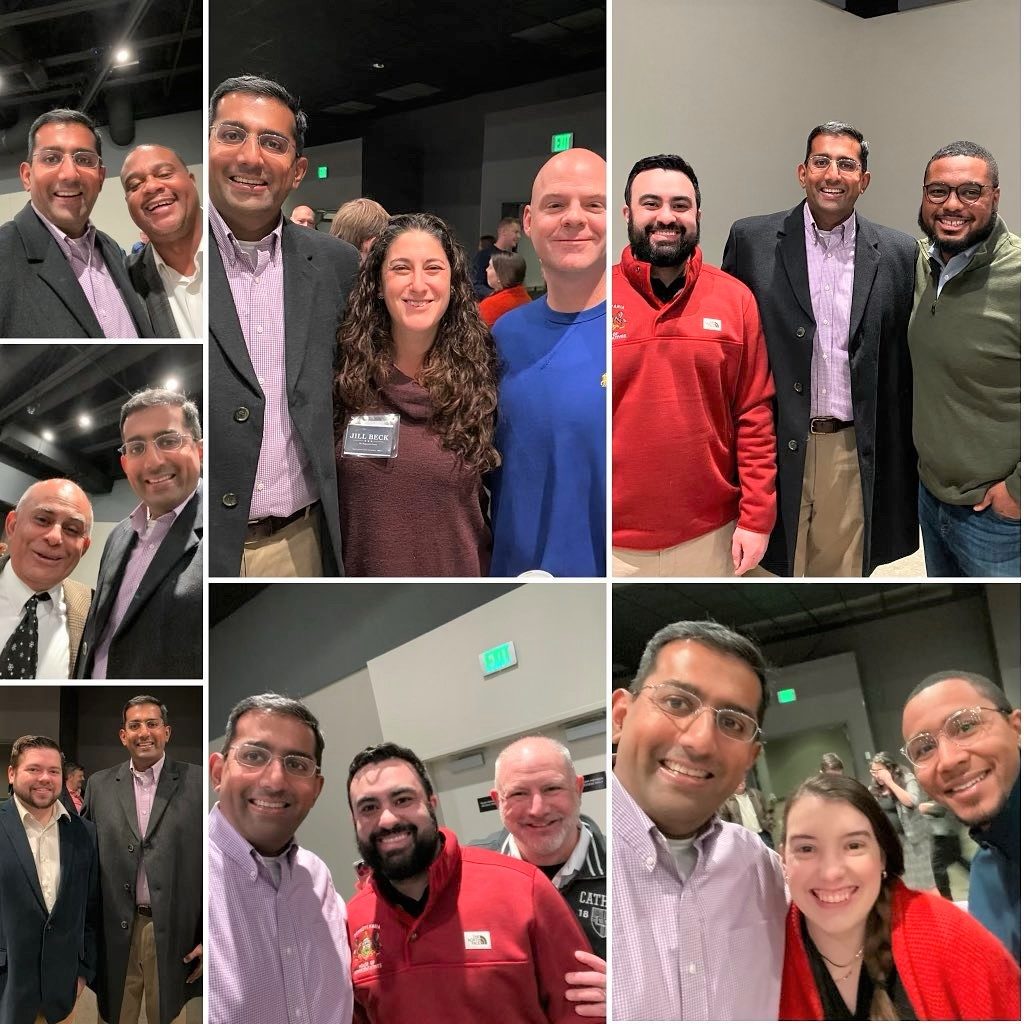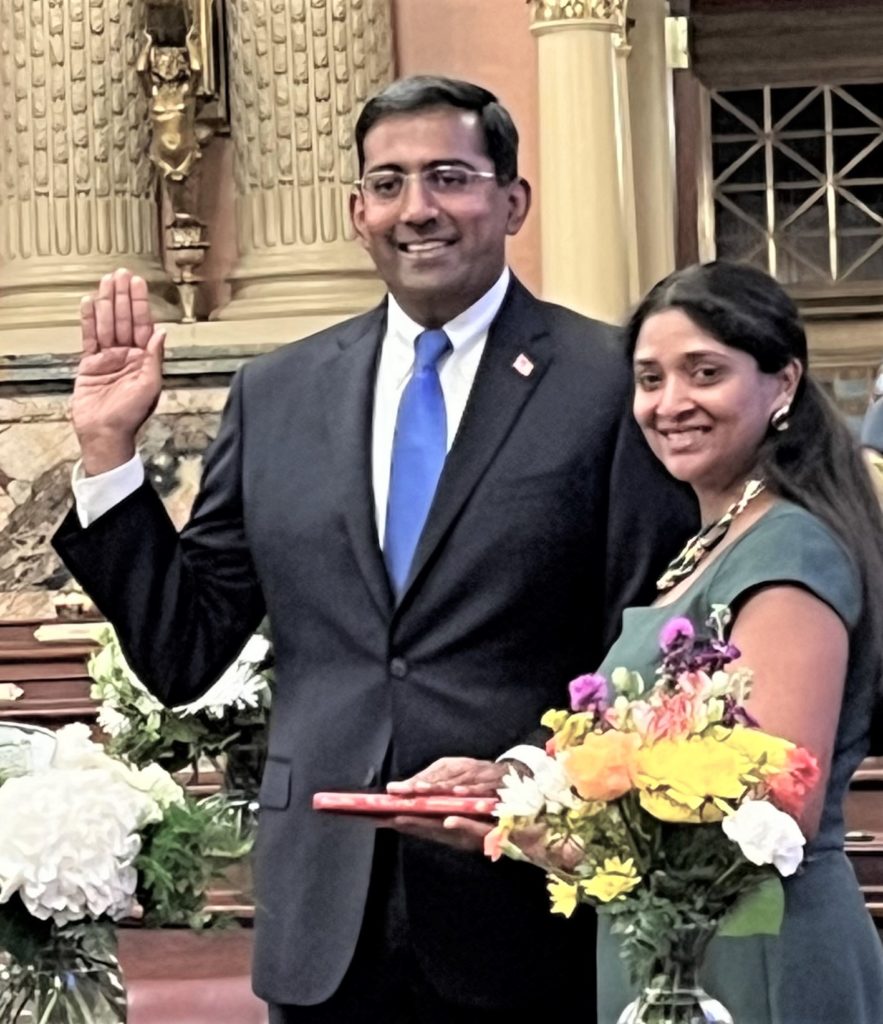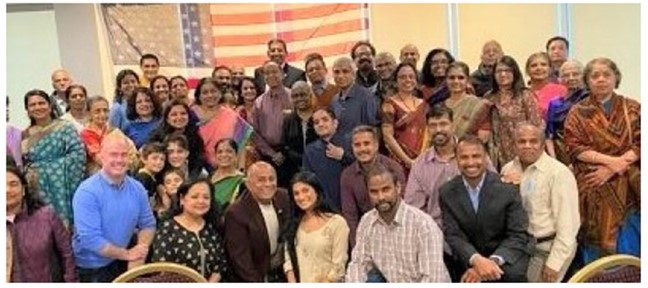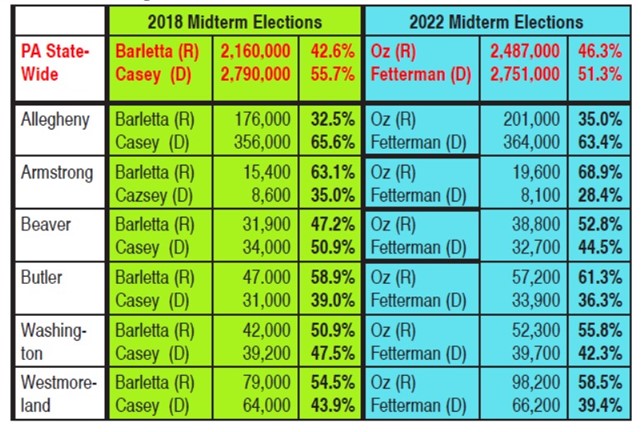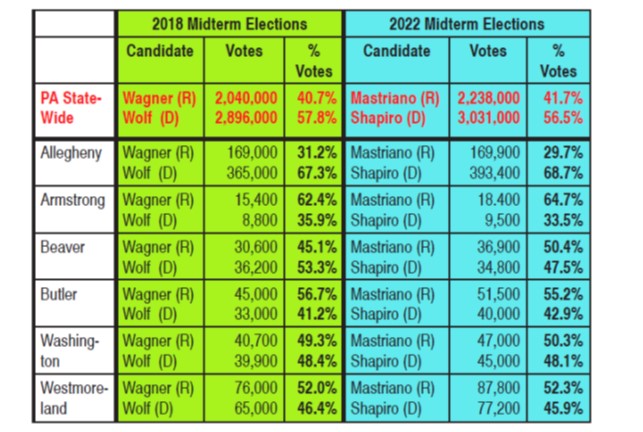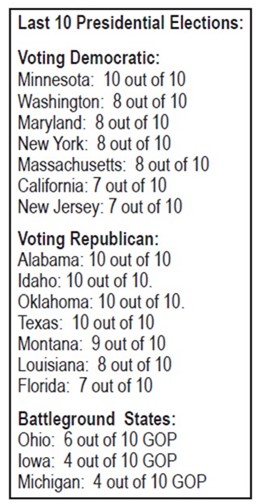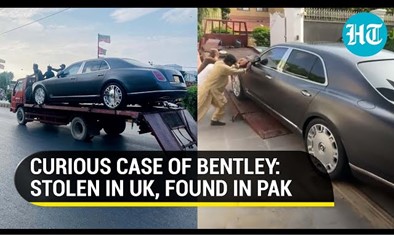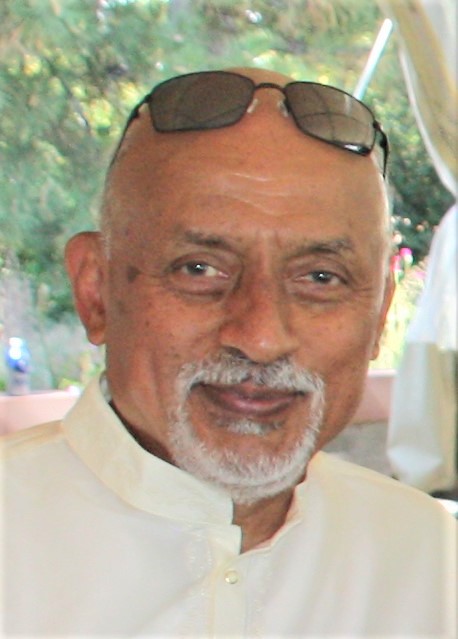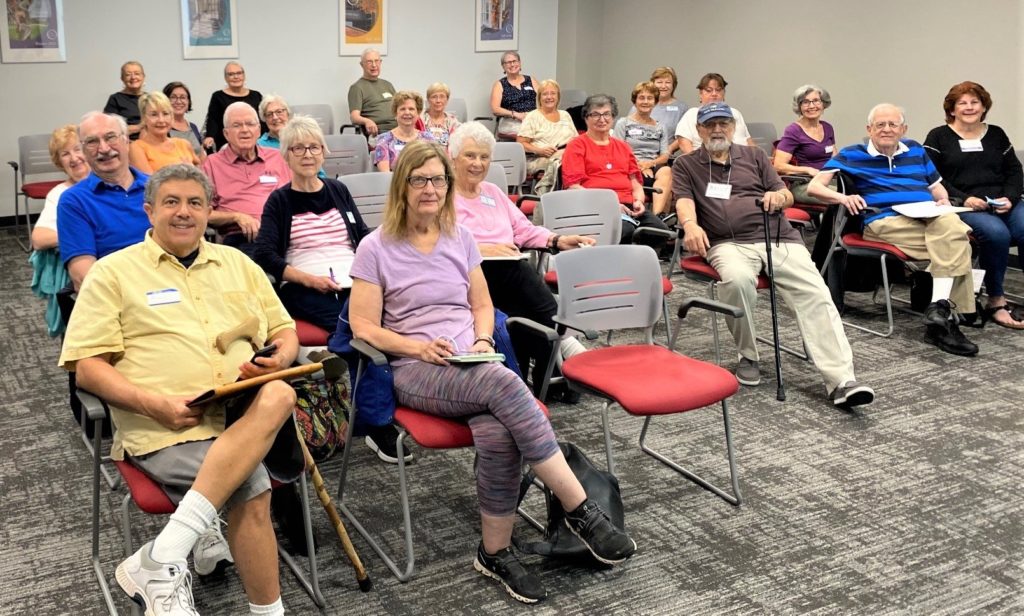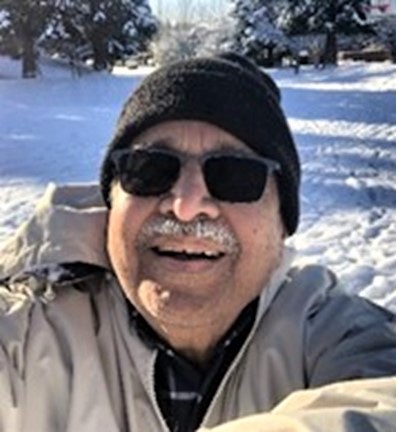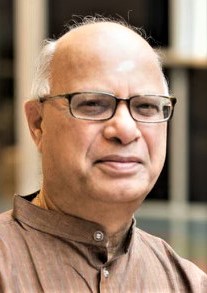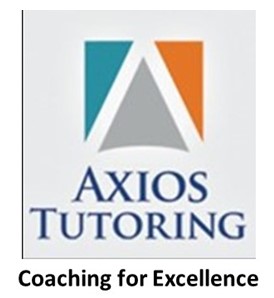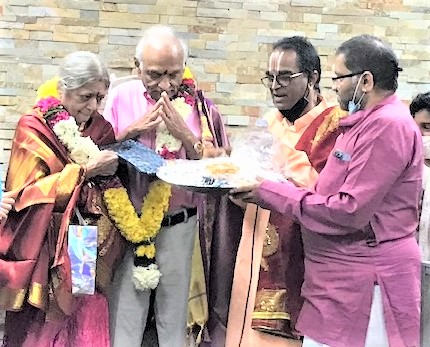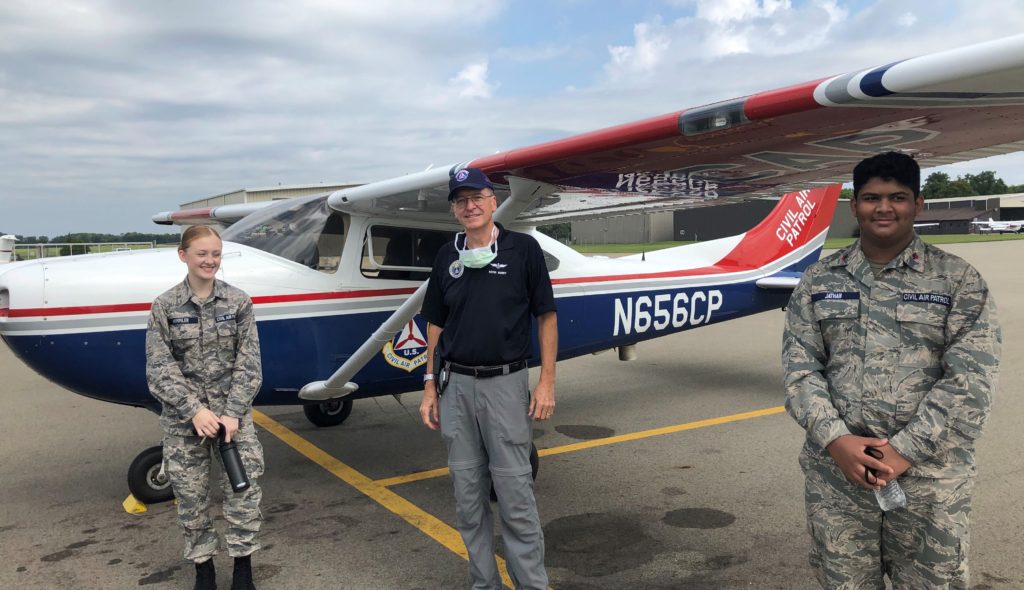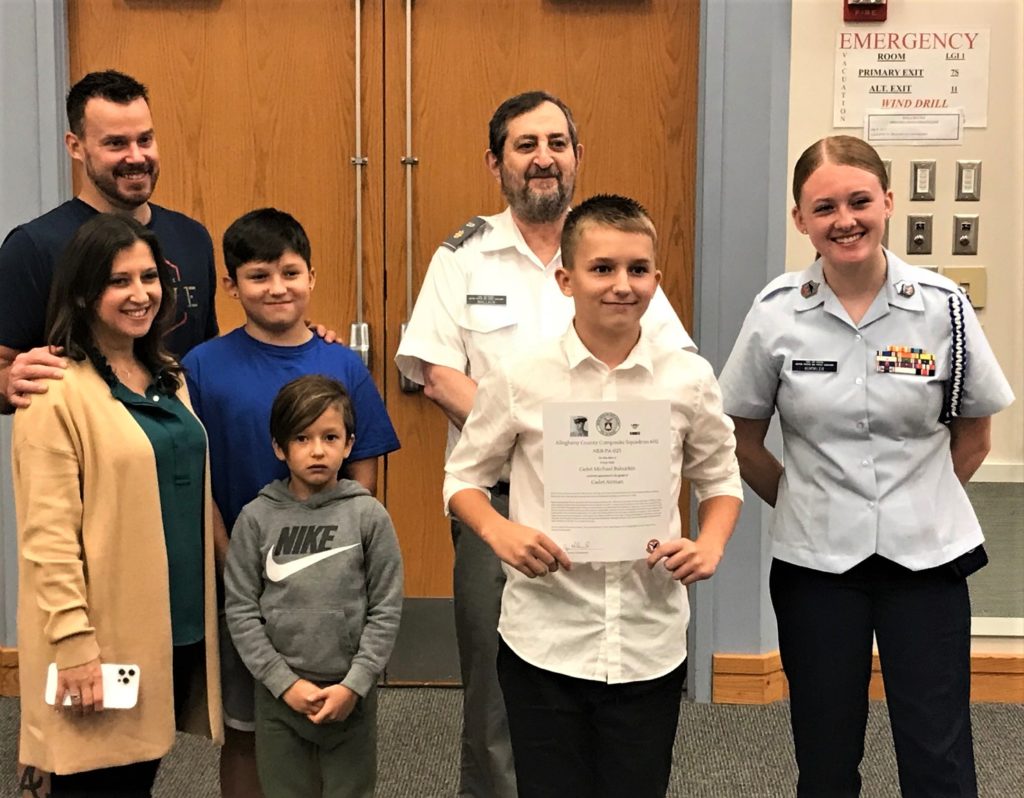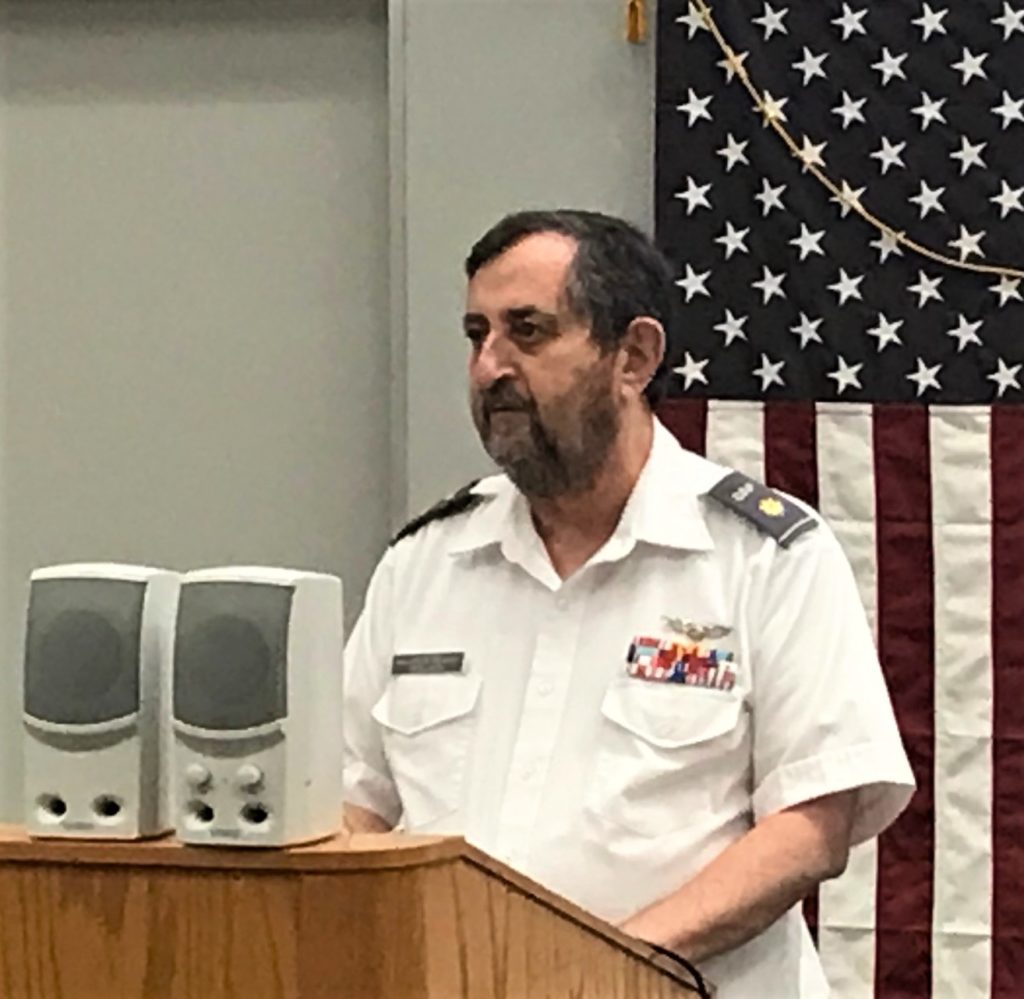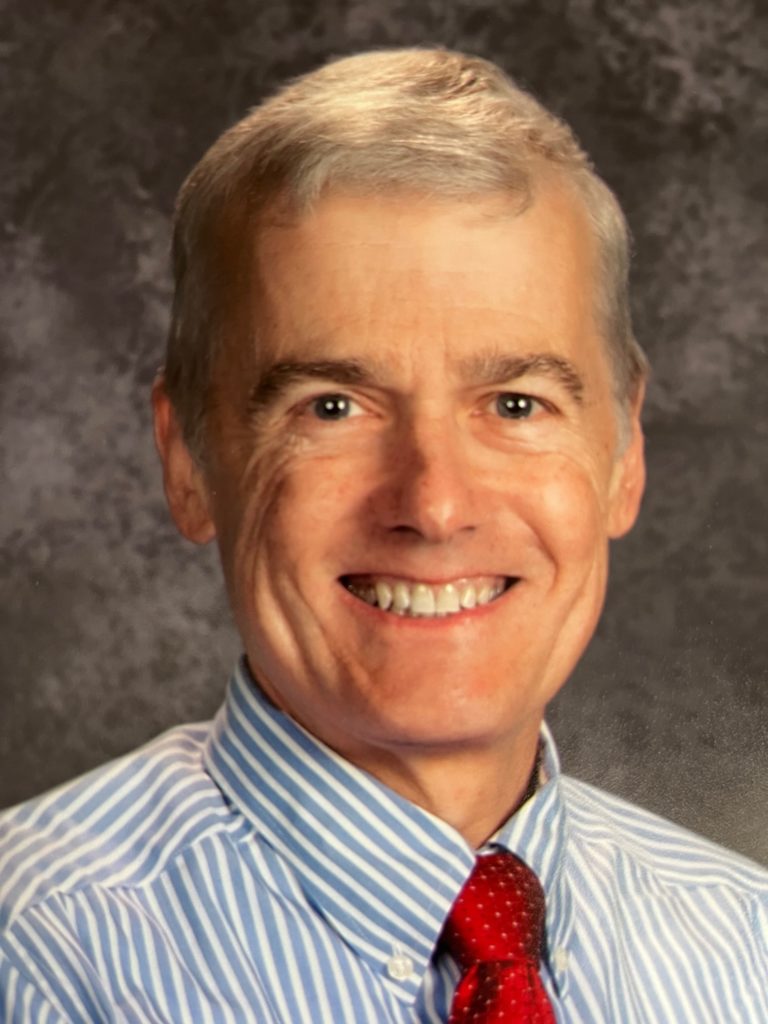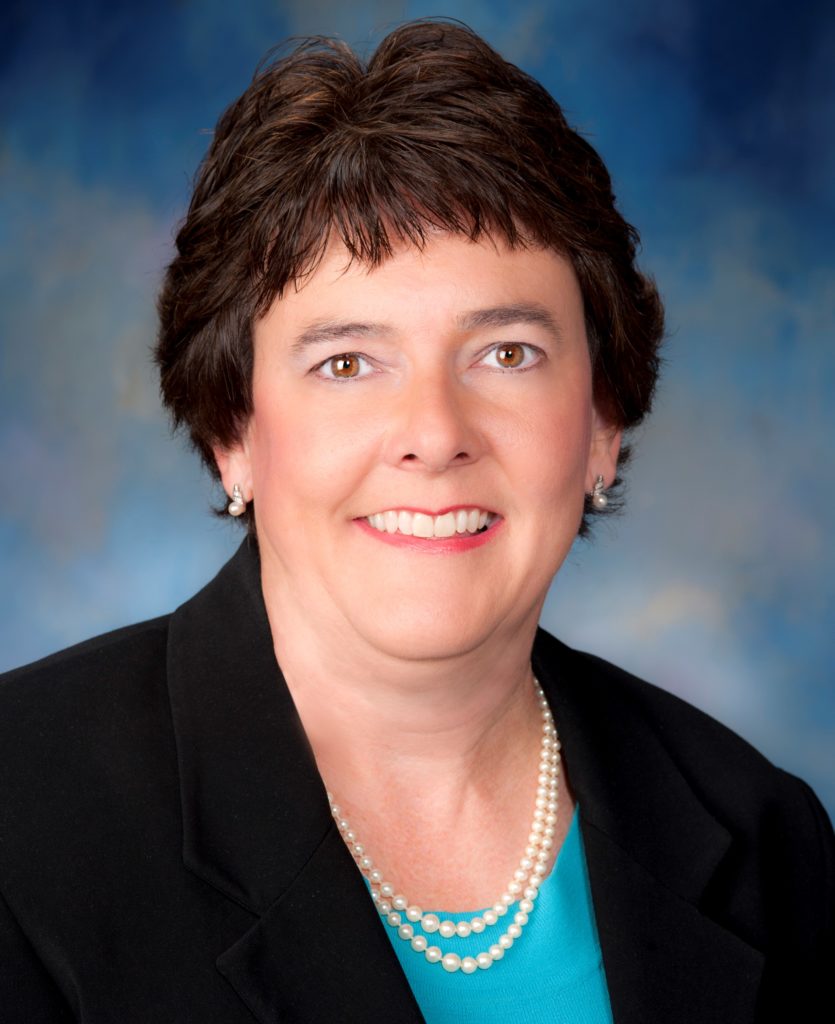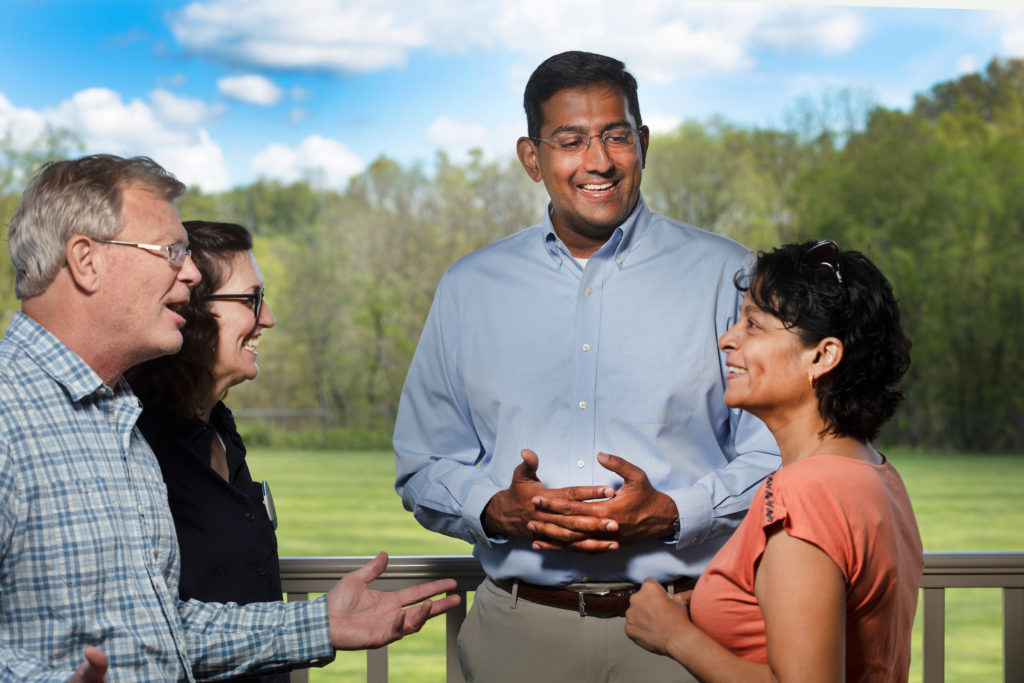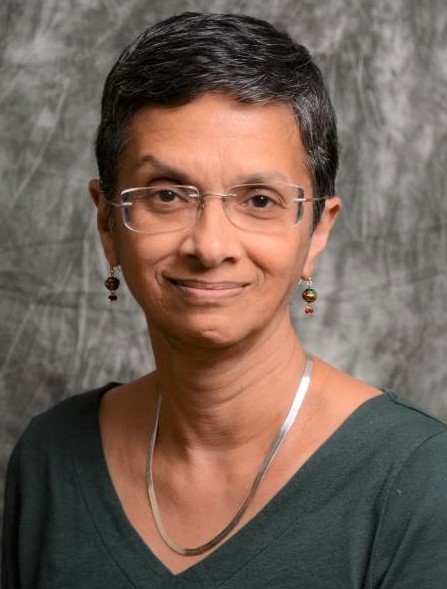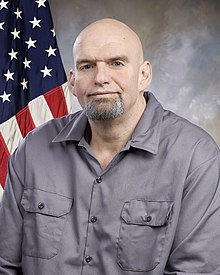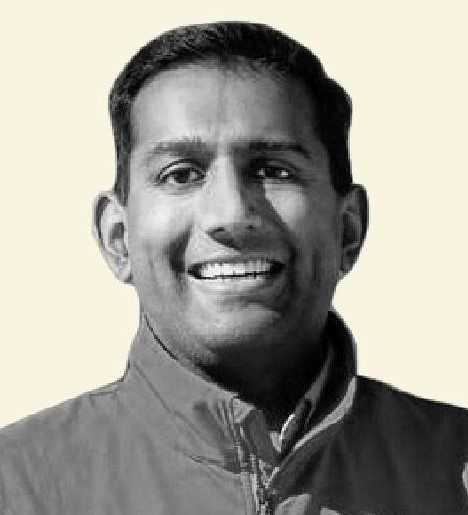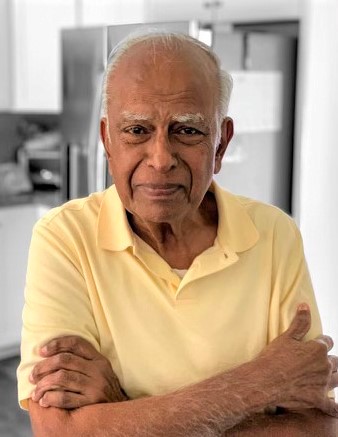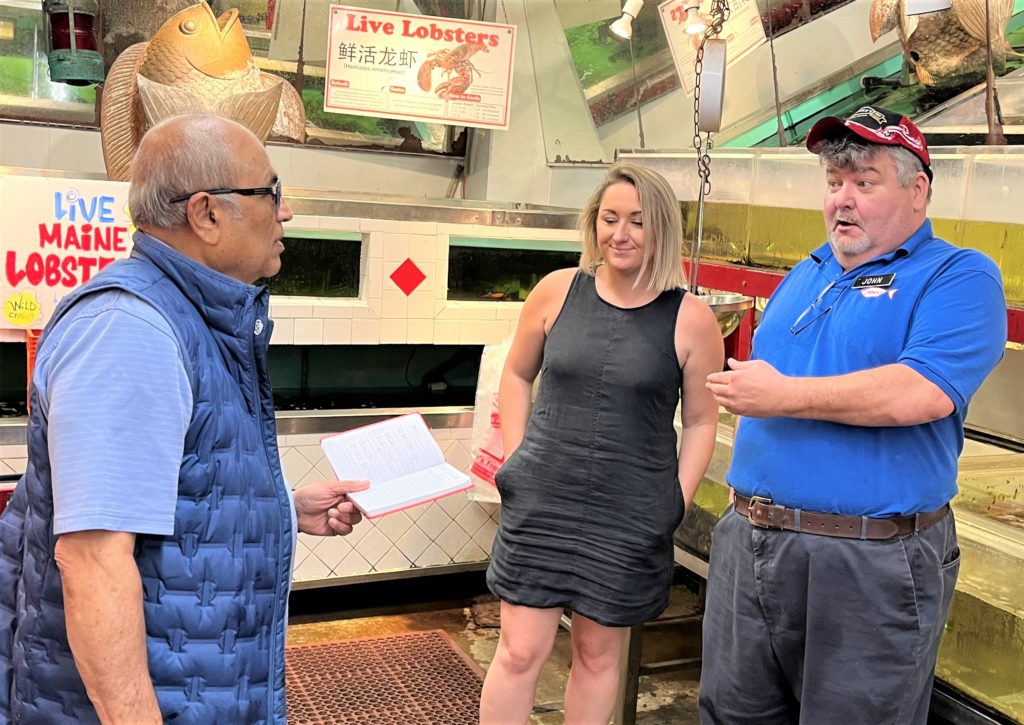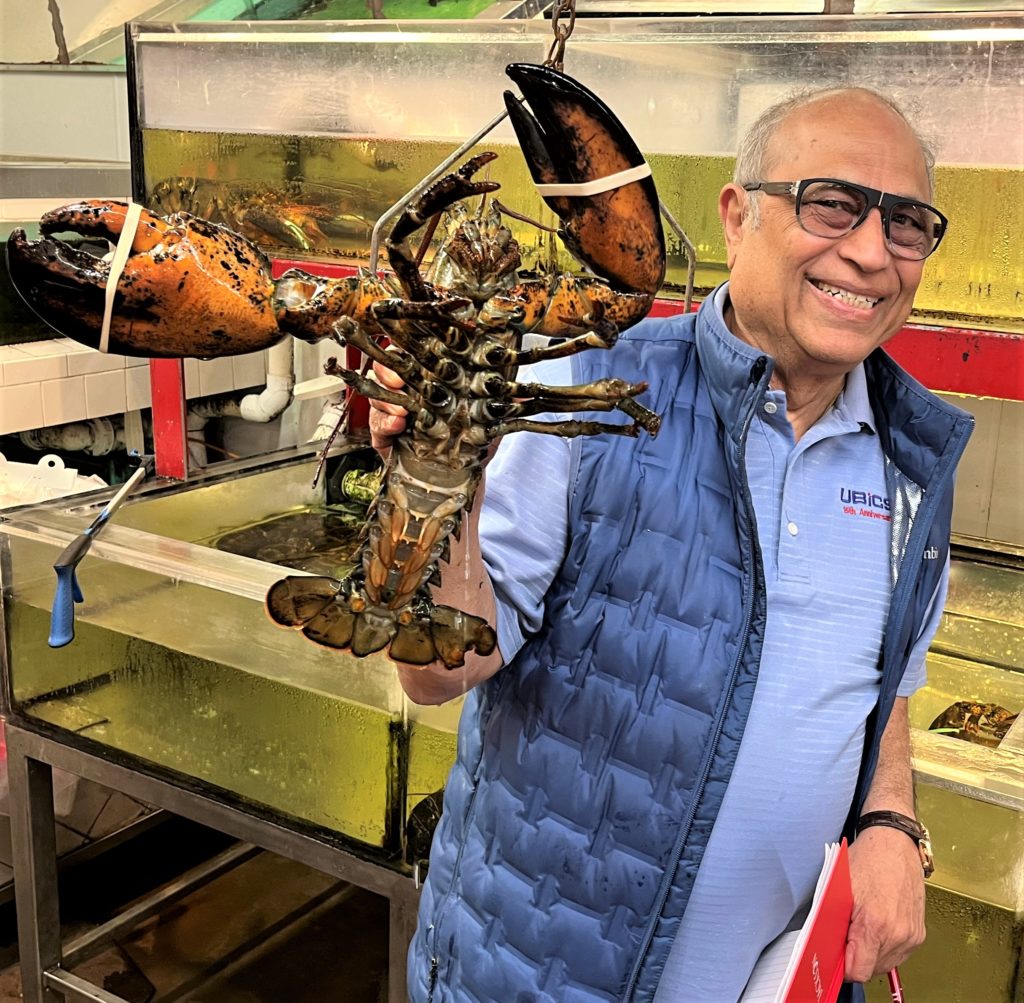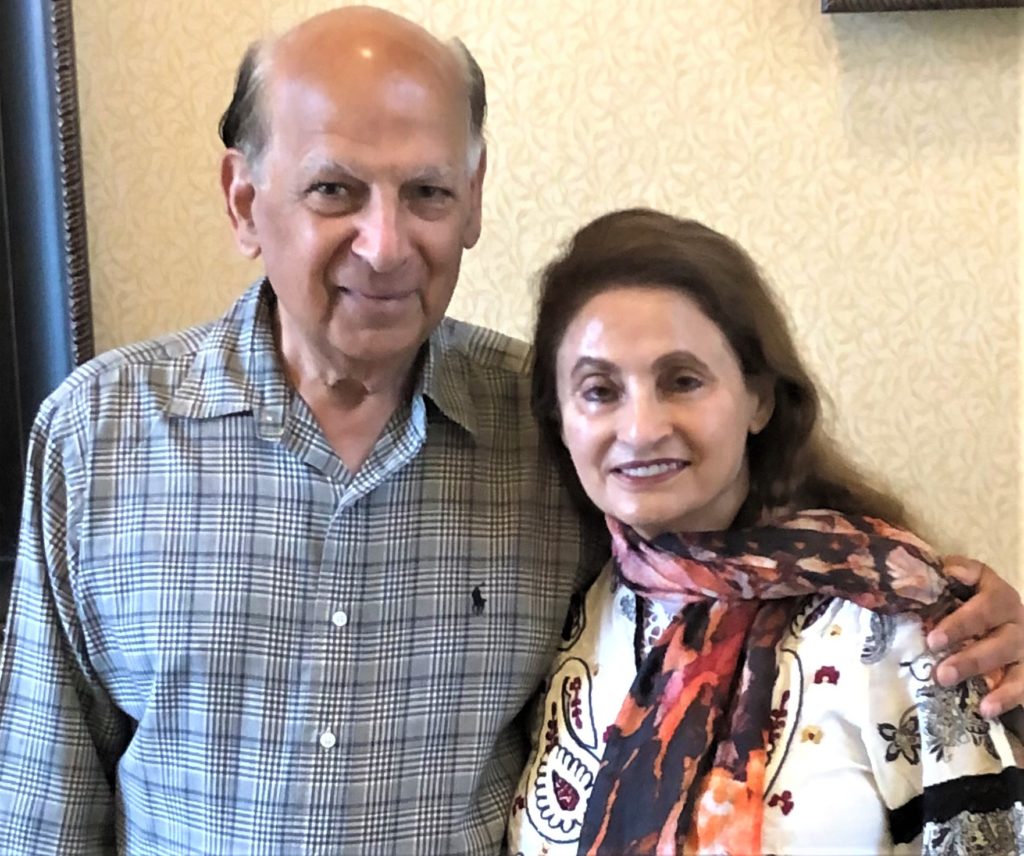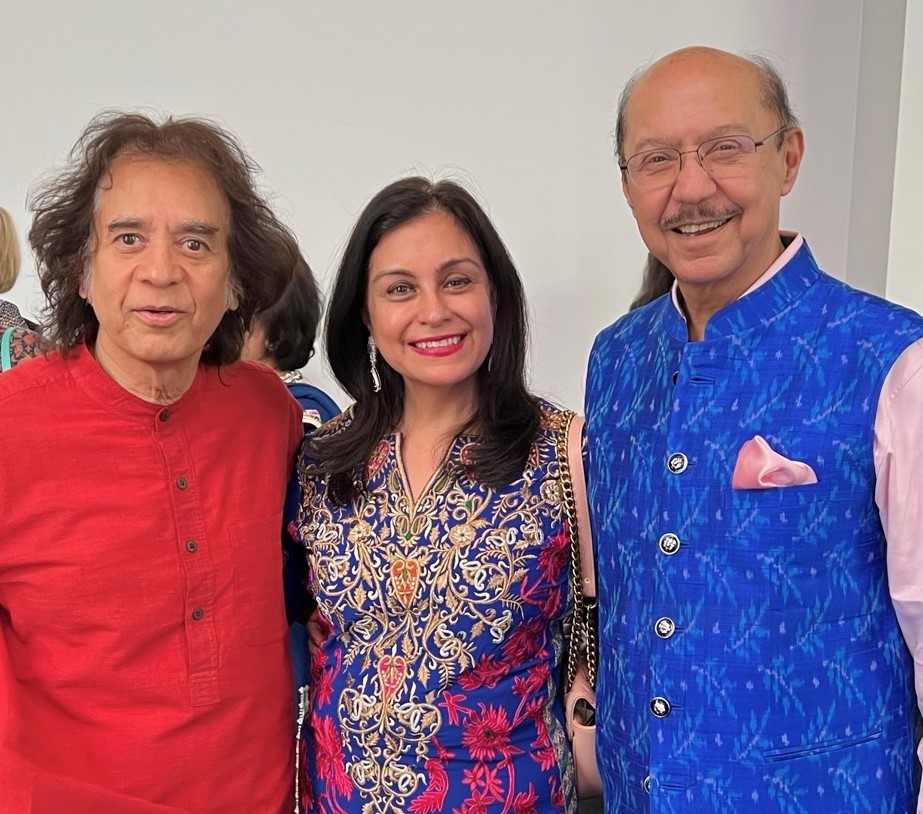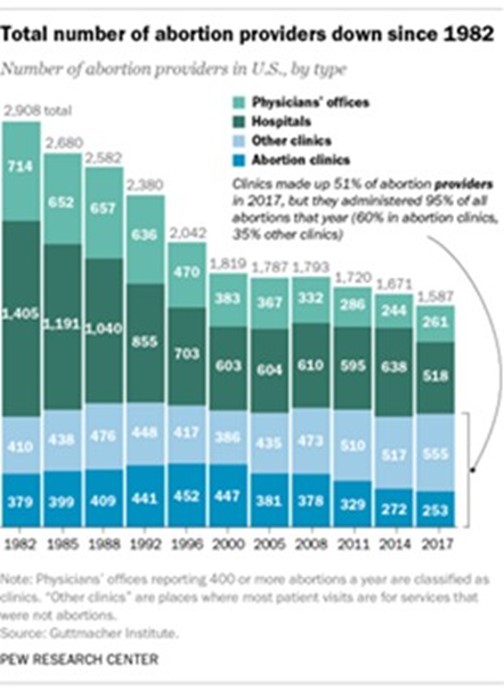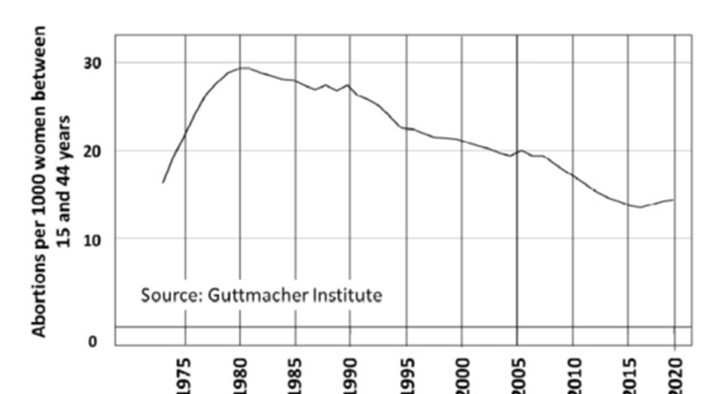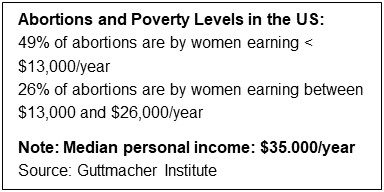Dr. Arvind Venkat, Pennsylvania’s First Indian American State House Representative
Posted by admin in January 2023, Past issues on January 12, 2023
By Ramita Ravi, New York, NY
Edior’s Note: Ramita Ravi, a Pittsburgh native, graduated from the University of Pennsylvania with a degree in Health & Societies. She moved to New York to pursue dance professionally and became the first Indian to be featured on So You Think You Can Dance. She dances for TV/film/theater and recently choreographed for Coachella, Miss America, and opened a Broadway bound musical. Ramita is Co-Founder and CEO of a tech startup incubated at The Wharton School: Artswrk, the world’s first marketplace to hire artists.
Born in Madurai, Tamil Nadu, Dr. Arvind Venkat immigrated with his parents to the Detroit area in his early childhood. His parents were young physicians when they came to this country. Like many others in their generation, they came to pursue a higher education in their fields. After their medical residency, his parents talked about moving back to India, but found a home in the strong Tamil community that was already growing in the Detroit Area, like in many other parts of the US in the 1970s and 80s.
Dr. Venkat went to Harvard University where he majored in History and Science. He wanted to become a lawyer, but after a law internship during his freshman summer, he decided to pursue medicine. Given his diversified interests, he felt that his undergrad education in history and science was a great fit to kick off his his journey on how the sciences of health intersect with society. He went to Yale University for medical school and did his emergency medicine residency at the University of Cincinnati’s Hospital.
In medical school, he met his wife Veena, a longtime Pittsburgh native. They got married and settled in Pittsburgh. As an emergency physician, Dr. Venkat was immersed in work at the critical intersection of healthcare and society – in the Emergency Room. He says with a deep sense of satisfaction, “In the emergency room, all patients get medical care regardless of their socioeconomic status, with no questions asked. It is the one place in America where most barriers to medical care fall away, and physicians make an immediate impact on people’s lives in life-threatening situations.”
Simultaneously, he joined the faculty at the Allegheny General Hospital working on public health programs from flu vaccination projects to training for EMS providers, and initiatives on the needs of those on the autism spectrum, and on the importance of a greater voice for emergency physicians and their patients. He started working with the Pennsylvania College of Emergency Physicians and eventually became the president of the organization, with opportunities to improve care in emergency rooms across the state.
A combination of these experiences gravitated Dr. Venkat to the public sector. “The real catalyst was the COVID-19 pandemic in 2020,” says Dr Venkat. “During the early days of the pandemic, it became clear to me that the public health system needs greater resources and resilience – and it also needs trust from the community at large. That is when I decided to run for elected public office to be a public health advocate and help pass legislation that would reach PA residents in times of dire need.”
Dr. Venkat launched his campaign on the Democratic ticket in February 2022 seeking to represent the 30th District in the Pennsylvania House of Representatives in Harrisburg. He spent the bulk of time knocking on a grand total of 13,000 doors. The 30th District in the Lower House of the Penna Assembly includes McCandless, Franklin Park, Ohio Township, Kilbuck, Emsworth, Ben Avon, Ben Avon Heights, and the western part of Hampton Township. The district is 85% Caucasian, 15% minority with South Asians making up about seven percent of the population. Its residents are mostly college-educated with a large STEM workforce and sa strong public school system.
“Taking time to make one-on-one connections with voters was the most important and most enjoyable part of my campaign,” says Venkat. “As I met my future constituents, I opened conversations around public health, public safety, and public education. I touched on difficult topics like affordable healthcare, women’s reproductive rights, and gun safety. I sometimes spent thirty minutes to an hour having a dialogue with folks on these tricky topics — even when they disagreed.” While this might not have changed his voters’ minds on those touchy topics, it certainly allowed them to hear the other perspective and reach common ground. Venkat says with great satisfaction, “The lesson from this is that having a willingness to meet people where they are and engage them in conversation is important to generate collective action and progress.”
The 30th District has a population of 64,000 residents. With 34,000 voters casting their ballots, In the November 2022 election, Venkat defeated his Republican opponent Cindy Kirk with a comfortable margin of 55/45.
In America, as everywhere else in the world, the reality of any electoral political campaign is that it needs money—a lot of it, in fact. “And this election was,” says Venkat ruefully, “a $2 million campaign for this single state house seat.” With 34,000 voters going to the polls, this campaign cost almost $59 per voter.
For comparison, in the 2020 presidential campaign, Biden and Trump got 81 million and 74 million votes respectively, with the two campaigns spending $5.8 billion. (Reference: www.tinyurl.com/2020PresidentialRace) This works out to the two campaigns together spending only $37 per voter in the 2020 US presidential race.
Just imagine, the 2022 election for Pennsylvania District 30 was more expensive per voter than even the 2020 US Presidential campaign! This is insane!
To raise funds, Venkat drew on support from friends, family, and community members who shared the importance of investing in the public sector and using resources to make their voices heard.
While the South Asian community generally shies away from electoral politics, Venkat spoke to South Asians here on the importance of being leaders and trailblazers in public life and in electoral offices. Venkat believes that, just because that representation has not existed to date does not mean it should not be a reality. He says, “We get the elected leaders that we deserve. In my nine-month long campaign, I received countless messages of support, had meaningful conversations, and felt energized by the idea of South Asians organizing to vote and making their voices heard in the political process.”
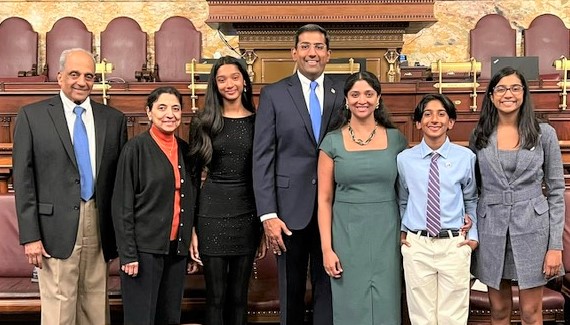
Dr. Venkat will head to Harrisburg to officially start his term in early January. When discussing what his early days will look like, a few things came up. First, the state house flipped control from Republican to Democrat (Democrats: 102, Republicans: 101). However, there are now three vacant seats from representatives who either moved to higher office or unfortunately passed away before the term began. As a result, there will be special elections for these seats. Dr. Venkat feels that it is imperative that these elections happen early so that each district has representation in the state house. Another Indian American, Bhavini Patel, has announced her candidacy to fill the vacancy in one of these open State House seats. If you live in that region, please look out for her, and learn about her work.
Once Dr Venkat is in office, he hopes to advocate for funding for early responders, investments in public education and childcare, policies around affordable and accessible healthcare, preserving reproductive rights for women at the state level, and expanding access to the ballot box through methods like early in-person voting.
While we as a country are often drawn to national elections, it is the state and local levels that closely affect our daily lives. Whether school board elections, county commissioner races, or others, these local elections require the same energy, turnout, and attention to make sure our voices are heard in the political process. Arvind feels excited that it is trending upward – in 2014, voter turnout was 30% nationwide, but this year it was 70% in his district — imagine if we only could inch closer to 90% to get elected leaders that represent all our voices.
It is with love, care, and support from the South Asian community, and communities at large, that Dr. Venkat ran in this race. He says he is a product of this community – his wife grew up here, they moved here, and they are raising their family here. As a community, it is imperative that we are engaged in the political sphere and make our voices heard – whether by supporting candidates, voting in every election, or running for office. We have the opportunity to share the values our families brought to the US and make this country even better for the next generation. Dr. Venkat is the first Indian American in this position in Harrisburg. He is confident and excited that he will not be the last. And so are we. ∎
The Way We Elect Our Leaders Is Not Reassuring
Posted by admin in January 2023, Past issues on January 12, 2023
By Kollengode S Venkataraman
There is widespread belief that American voters judiciously elect their leaders after evaluating their candidates and the issues they confront in national elections. This is because globally, the United States’ history in electoral politics has gained mythical dimensions, eventually getting into high school textbooks in many parts of the world. However, we can make a case that American voters in the aggregate are not that discerning in electing their leaders. This is despite our long traditions in grass roots democracy since the days when the Pilgrims arrived in Massachusetts on the Mayflower in the 17th century. Our voters seem to follow their past voting patterns based on their beliefs, ideologies, deeply held anxieties towards change, even prejudices.
A more troubling pattern in the US is the sharp differences in the voting patterns among the urban, suburban, and rural populations. These groups live in silos, with little efforts to understand each other’s hopes, priorities, and anxieties. Worse still, they live with mutual disdain and condescension towards each other despite all the wonders of instantaneous communication and affordable gadgets for disseminating information. One can even make a case that the silos mentality is because of the instantaneous and affordable access to information, with well-funded campaigns that only reinforce people’s beliefs and prejudices.
This situation makes it difficult for building consensus to bring about changes with minimum discord. This is becoming a global trend in developing and less developed economies with ominous consequences.
In the 2022 midterm elections in Pennsylvania, we had “open seats” for the US senate and governorship, with the none of the GOP and Democratic candidates having the benefit of incumbency. For the US Senate, the candidates were Mehmet Oz (R) and John Fetterman (D); and for the governorship, Doug Mastriano (R) and Josh Shapiro (D).
Even though the seats were “open,” candidates Mastriano, Fetterman and Shapiro were not new to electoral politics in the state. Fetterman was the elected lieutenant governor for the retiring governor Tom Wolf, and Shapiro was the elected Attorney General, both having won in state-wide elections. While Fetterman and Oz won in the party primaries early in 2022, Shapiro was unopposed in the primary.
Mastriano too was not new to electoral politics: he is the state senator in Harrisburg for District 33 comprising Franklin and Adams counties, part of what is known as “the Dutch Country.” He won in the party primary for the governor’s office. Mastriano is a US army veteran (30 years), retired as a colonel after serving in Europe during the Cold War, and in the wars in Kuwait, Iraq, and Afghanistan.
The GOP US Senate candidate Mehmet Oz, a New Jersey native and a retired cardiothoracic surgeon, was a TV personality promoting health fashions in Oprah Winfrey’s morning shows. Oz was new to electoral politics—not having contested even in school board elections—and an “outsider” in Pennsylvania. But Oz had the backing of President Trump.
These “open seat” situations gave an opportunity to study the voting patterns in the “urban” Allegheny County (with Pittsburgh at the center) vis-a-vis the five surrounding suburban counties. See the picture below.
Fetterman (D) was a “local” candidate with an unusual background. He was born in southeast Pennsylvania to parents who were nineteen years old at the time of his birth. He was raised in affluent suburban York, PA and his parents were Republicans.
While Fetterman was studying at the University of Connecticut for his MBA, his best friend died in a car accident that deeply affected him. Later, Fetterman joined the NGO Big Brothers Big Sisters of America, pairing with an eight-year-old boy in Connecticut whose parents both died of AIDS. He worked for two years in Pittsburgh in risk management as an underwriter. In 1995, he joined the AmeriCorps, and was sent to teach Pittsburgh adults pursuing their GEDs, giving a second chance to people who did not complete high school. He later went to Harvard’s Kennedy School graduating in 1999 with a master’s degree in Public Policy. (Source: Wikipedia)
Fetterman is known in our region as the Mayor of Braddock between 2006 and 2019, a rundown municipality in the Mon Valley (once a thriving place in the heydays of Mighty Steel decades ago), now known for poverty, violence, and crime. His work in Braddock gave him national recognition.
With this background, Fetterman was seen by many as a shoo-in candidate for voters in our region, given that his opponent Mehmet Oz, a multimillionaire TV doctor was seen as a carpetbagger from New Jersey.
Oz, the son of Turkish immigrants, raised in Wilmington, Delaware, is a dual citizen of the US and Turkey. He went to Harvard University (biology undergraduate), and later to the University of Pennsylvania (medicine and MBA degrees). In 2001, he became a professor of surgery at Columbia University and was a well-recognized cardiothoracic surgeon. In the early 2000s, Oz was a regular guest on The Oprah Winfrey Show. In 2009, he started his own The Dr.Oz Show, a daily television program on health and medicine, running for thirteen seasons. Oz dabbled in alternative medicine, faith healing, and various paranormal beliefs that earned him criticism from a number of medical publications and physicians (Source: Wikipedia).
Given this contrast between Fetterman (D) and Oz (R) as candidates for the US Senate, I too expected that Fetterman would have no problem harvesting votes from our region of the six counties, namely the urban Allegheny County and the surrounding five suburban counties. But an analysis of the votes polled in the elections revealed something quite different and significant in US electoral politics. The voter data extracted for this story is from www.electionreturns.pa.gov/#
Historically in US elections, there are significant differences in the voter turnout between the quadrennial presidential elections and the biennial midterm elections. Therefore, comparing the voter data in the presidential elections with those in the midterm elections may muddy the analysis. Therefore, the results of the midterm 2022 are compared with those of the midterm 2018 elections. The table below shows the results of the 2018 and 2022 midterm elections.
In the 2018 midterm elections for the US Senate, Bob Casey (D), the incumbent US Senator, ran against congressman Lou Barletta (R), the GOP candidate for the US senate. Barletta too, like Oz, had the former President Trump’s endorsement.
On the statewide votes count (red letters at the top of the table), in the 2018 midterm elections, the Democratic incumbent Casey with 56% of the votes defeated Barletta who got 43% of the votes. In the 2022 election, the Democrat Fetterman, the PA native son, could defeated the outsider Republican Oz only with a narrower margin of 51% vs Oz’s 46%.
Incidentally, after nearly 80 years, Pennsylvania now has both US senators from the Democratic Party. The last time this happened was in the 1940s. In that sense, there is a big palpable change on the electoral politics in our state, partly attributable to the redistric https://www.msn.com/en-us/feed ting of electoral maps.
When we drilled down the voter data for the counties in our region, the numbers are quite revealing. Historically, the highly urban Allegheny County, as urban counties everywhere in the US, has always been heavily Democratic.
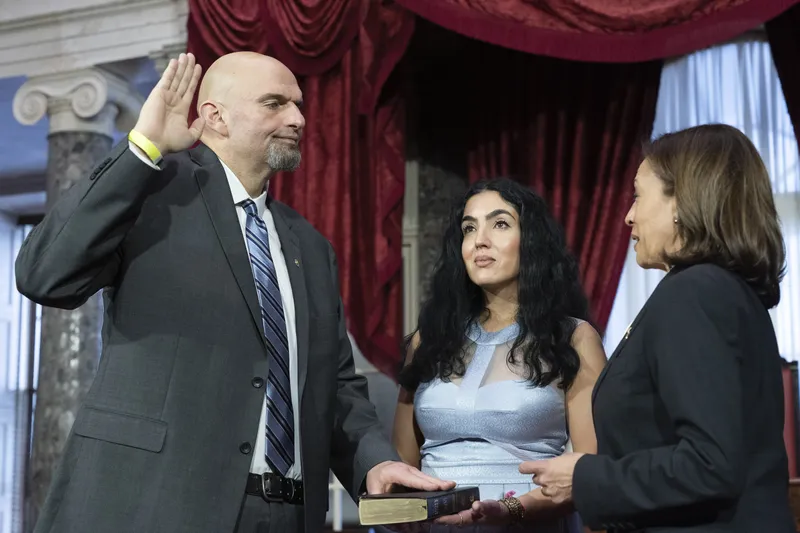
Therefore, in the 2018 Midterm (green part of the Table), in Allegheny County, the vote split between Casey and Barletta was 66/33. For Fetterman in 2022, the vote split against Oz was narrower, namely, 63/35. It is noteworthy that even though Fetterman is from our region with an impressive record, he got only 63% of votes in Allegheny County against OZ, an outsider from New Jersey, lower than Casey’s 66% of votes against Barletta.
Again, historically, all counties surrounding Allegheny County have always been consistently Republican, some more, some less. This is a common trend between the urban and the surrounding suburban counties in all fifty states in the US. Compared to the 2018 midterm, in the 2022 midterm elections, all the surrounding counties voted even more heavily Republican. See below:
2018 Midterm 2022 Midterm
Armstrong County: 63% GOP 69% GOP
Beaver County: 47% GOP 53% GOP
Washington County: 51% GOP 56% GOP
Westmoreland County: 55% GOP 59% GOP
Fetterman, a Harvard MBA, is a “native” local candidate heavily invested in the region, with an impressive track record, serving as mayor in one of the most depressed municipalities in our area. Even with such a record as Fetterman’s, the Democratic party still got a smaller percentage of the votes in the 2022 midterm against the GOP’s outsider Oz, compared to what the Democratic party got in the 2018 midterm race for the US Senate.
That is, irrespective of the merits and track record of the candidates and his/her political roots in our region, citizens here, in the aggregate, voted only based on their party affiliation, political ideologies and visceral Red-Blue identities, and deeply held beliefs and prejudices. The individual candidate’s qualifications, personal track records and roots in our region did not seem to matter.
In the gubernatorial elections too, the 2022 midterm was an “open seat” between Shapiro (D) and Mastriano (R). Both were in state elective politics, with Shapiro as the attorney general and Mastriano as a state senator in the General Assembly in Harrisburg. Both were “native” Pennsylvanians. See the table below for the voting data. It is noteworthy that in the two midterms, the percentage of votes the two parties got were remarkably close. In the aggregate, the votes the candidates received were more dependent of voter’s political ideologies and party affiliations between the GOP and the Democratic parties, and not necessarily on the candidates’ track records.
This pattern in political affiliation among people in urban counties (heavily Democratic) and suburban counties (heavily Republican) is seen throughout the United States. And when you add the rural counties into this mix, the interior rural counties tend to be even more Republican than suburban counties.
Another important feature in the US presidential elections is that many states have repeatedly voted for either the Democratic or the Republican presidential candidates. This is irrespective of who the candidates were, and no matter what the burning economic, military, foreign policy, or cultural issues at the time of election have been. See the table below showing how the states voted in the last ten presidential elections — over a 40-year period, nearly two generations.
Also, the population densities in urban counties are several times that of the suburban counties. Example in our region: Allegheny county’s population density is 1650/sq. mile, while that of neighboring Westmoreland County is 350/sq mile and that of Armstrong County is only 100/sq mile. The population densities in suburban counties, in turn, are orders of orders of magnitude higher than the population densities in rural counties (the population densities of Bedford, Bradford, Cameron and Clarion Counties are 50-, 50-,70- and 10 per sq mile.
The US has been the dominating force in the last 80 years in wealth creation, global politics, military might, sports, entertainment, R&D, higher education, and communications and electronic news media… … Not only the outside world, but even Americans themselves—at least a large cross section of Americans—seem to believe in what has come to be known as American Exceptionalism. Hence there is widespread belief in Asia (and in Africa and Latin America) that Americans, with their grassroots tradition in electoral democracies make judicious choices in electing their leaders.
However, American voters in the aggregate, as shown in this analysis, are not as discerning as they are believed to be in electing their leaders. This despite their long traditions in grass roots democracy since the days when the Pilgrims arrived in Massachusetts on the Mayflower in the 17th century. They seem to simply follow their past voting patterns based on their beliefs, ideologies, even visceral fears, and prejudices.
A more troubling pattern in the US is that the urban, suburban, and rural populations live in silos, with little effort to understand each other’s hopes and anxieties; and worse still, with mutual disdain and condescension towards each other. This is makes it difficult to build a consensus needed to bring about changes with minimum discord. These three groups could as well be living in different countries and cultures. ∎
A Bentley “Stolen” in London Found in Karachi
Posted by admin in October 2022, Past issues on September 25, 2022
A bizarre story indeed: A Bentley Mulsanne luxury vehicle costing over $200,000, allegedly “stolen” from London was found in Karachi’s upscale Defence Housing Authority (DHA) residential area, originally developed for high-ranking retired Pakistani military officers. Many retired officers sold their homes at HUGE profits to private citizens.
In September 2022, the Customs Office in Karachi received a tip from a “friendly country” on the precise location — the street address in the DHA complex — of the Bentley. When Pakistan’s customs officials went to the upscale house, lo and behold, the Bentley was in the parking garage. In a story in Dawn, Imtiaz Ali reports this:
The officials asked the ‘owner’, Jameel Shafi, to provide the title for the vehicle. Instead of producing the papers, Mr Shafi stated that the vehicle was sold to him by one Naveed Bilwani with the agreement that Mr Bilwani would bear all liabilities to clear required documents from authorities before November 2022. As the “owner” could not produce the document of the vehicle, the customs department took possession of the vehicle.
Later, during investigation, Bilwani informed officials that he had only helped broker a deal between Shafi and another person named Naveed Yamin as a guarantor of payment and papers and Mr Yamin received cash from Shafi as payment against the vehicle.
n a later story Dawn tells that the 2014-model Bentley was imported in 2019 by the Bulgarian ambassador to Pakistan, who later sold it to a Pakistani, which is illegal because it circumvents a whopping 300% import duty for such luxury vehicles. A whole bunch of government officials in Pakistan’s customs department, DMV and other agencies are now caught up in the scandal. Once so many government officials are involved in a scandal, as it happens in that part of the world, nobody will be held accountable.
The expensive car had a microchip installed to track its location. If only any one of the people in this scandal knew to deactivate the microchip, this scandal would not have exploded the way it did.
London’s British Museum displays artworks the empire stolen from India during its colonial occupation. One wonders if Pakistan would remember this and keep the Bentley for display in Karachi or Islamabad. ∎
Book Review: Dhananjay Joshi’s “No Effort Required”
Posted by admin in October 2022, Past issues on September 25, 2022
No Effort Required is the English translation of Dhananjay Joshi’s articles in Marathi, serialized under the title Sahaj in Lokamat, the Marathi daily. The word सहज, taken straight from Sanskrit, means born with, natural, effortless, or congenital. Arun Jatkar, known to our readers, and a cousin of Joshi’s, translated the series into English.
The theme of this book is the author’s reflections on his decades-long spiritual quest on the purpose and meaning of life. This takes him from his cultural moorings in his traditional Hindu upbringing and interactions with family elders like his grandmother and several teachers in India. This search continued through his engineering education in Poona. Later, when he came to the US for higher education at the Illinois Institute of Technology in electrical engineering and mathematics, his quest continued. He had long interactions in the US with the monks at the Ramakrishna Math and with Zen masters from Korea and Japan.
As many Hindu/Jain/Buddhist/Sikh teachers in India have repeatedly advised us in each generation, tranquility and freedom (Moksha in Sanskrit) are to be realized here and now when we are alive, and not in Swarga, Heaven or Jannat, post mortem — I use post-mortem in the literal meaning of the phrase, namely, after death. This idea is also central to Buddhist teachings all over Asia.
The author’s spiritual journey continued while he was living in Chicago, starting his career in corporate America, with him organizing meditation retreats in his rented apartment. And later, leading life as a married man, paying taxes and educating his children. He did not run away to the foothills of the Himalayas between career transitions, or out of disillusionment in life in the US. When people are predisposed to these kinds of pursuits, they get — or find — their teachers, even in Chicago, even in the midst of all the regular grinds that overwhelm most of us.
Serious English readers in India — the book’s target audience since it is published there — are in a hurry, used to rapid reading. The short, easily readable stand-alone stories in the book are suitable for these readers. However, just because the articles are short and readable, it does not mean that readers can absorb their central messages in rapid reading. Several articles in this collection, described as “pointillist” by Margaret McKenzie in her foreword, are cryptic and end abruptly. If readers do not pay attention in their speed reading and do not pause at the end of each story, they may altogether miss their import.
This pointillist style of the short pieces, each standing on its own has a long history in Indian literature. Examples are the one hundred verses in Vedanta Dindima (attributed to Adi Shankara, perhaps incorrectly), or the 1330 couplets in the 2000-year-old Tamil classic Tirukkural. These individual verses are like bananas in a cluster, each complete by itself, independent of others in the bunch.
Many of the lessons the author learns from his Zen masters are the same that the Hindu tradition teaches, namely patience, frugality, simplicity, honesty (to oneself) in one’s life and lifestyle, and diligence, persistence, efforts, and dispassion in one’s pursuits.
On reading the short pieces in the book, spontaneously I recalled the great line मन एव मनुष्याणां कारणं बन्धमोक्षयोः (Mind and mind alone is the cause for both the bondage and liberation of man) from the Amritabindu Upanishad, or अभ्यास-वैराग्याभ्यां चित्तवृत्ति निरोधः (With practice and detachment, a vacillating mind is quietened.) from Patanjali’s aphorisms.
Another lesson that comes out in Joshi’s writings is what is stressed in traditional Indian teachings, namely, the importance of right motivations in our pursuits. Even if we pursue the right course of action, but with the wrong motivations, we are advised, we will be dissatisfied with the outcome. And even when we pursue seemingly unpopular and unproductive objectives, but with the right motivation, eventually we will come out OK.
The stories are easily digestible, but are difficult to read because of the small font size and tighter line spacings. The publisher could have fixed this since there are wide margins on the left-hand-side pages in the book. And there are random distractions of missing spaces between words, a feature that was easily fixable with today’s editing software. But for these features, the book is worthy of reader’s’ time since it addresses in a contemporary style and context many issues young professionals face.
No Effort Required Author: Dhananjay Joshi, Translation: Arun Jatkar, Publisher: Rohan Prakashan, 155 pages. Pune, India. INR 300.00
Reviewer: Kollengode S Venkataraman ∎
Continuing Education at CMU for Seniors in Retirement
Posted by admin in October 2022, Past issues on September 25, 2022
By Sankar Seetharama, Pittsburgh, PA
One of the best kept secrets in the Pittsburgh metropolitan area, the Osher Lifelong Learning Institute at Carnegie Mellon University (CMU), offers its members, primarily the senior community, opportunities to expand their knowledge, enhance their skills, interact with their peers, and increase their social and cultural awareness. It provides members a range of short-term, non-credit courses, lectures, and field trips, taught by faculty from CMU and other institutions, retired business professionals and representatives from community organizations, all eager to share their knowledge and expertise.
In August 1991, Robert Mehrabian, Carnegie Mellon University President, brought in Steve Calvert as assistant VP and director of alumni relations to found an adult education program. Mehrabian’s vision was to strengthen alumni relations, including a focus on education programs for alumni and the University’s neighbors, primarily retired adults still thirsty for knowledge.
Guided by Gretchen Langford, a Margaret Morrison Carnegie College alumna, and Edwin “Ted” Fenton, alumnus, Director of CMU’s Center for University Outreach, the Academy for Lifelong Learning (A.L.L.) came to be in 1992. In its first year (1993-1994), it drew three hundred students.
By 2007, A.L.L. had grown to over 1,200 members. Following a grant from the Bernard Osher Foundation, the A.L.L. Board of Directors recommended joining forces with the Osher Lifelong Learning Institutes, dedicated to the same goals. By early 2009, Osher at CMU had new offices in Hunt Library, two classrooms in Wean Hall, a website, and an endowment from the Osher Foundation.
Now all of these have been consolidated in a lovely new Learning Center in Cyert Hall on campus funded by the Osher at CMU and local foundations. Osher, not part of CMU, is an independent, 501(c)3 non-profit organization. Most importantly, it is volunteer-driven. From the Board of Directors to its committees and its instructors, everyone is a volunteer. It helps reinforce a sense of community. There is also a dedicated staff, responsible for running the show. Led by an Executive Director, they produce course catalogs, schedule courses, maintain the website, help with registration, and take care of all the business aspects of the organization.
Each year, members can choose from over four hundred courses, covering an incredible range of subjects from the study of a Shakespeare play to under-water photography, secrets of Pittsburgh, architecture, Indian history, music, personal finance, legal issues, health & wellness, and much more. Most of these classes are taught in the Learning Center in Cyert Hall.
Beginning in August of 2019 Osher’s Executive Director and then President had a series of meetings with Chatham University’s President. These meetings led to the Lifelong Learning Program partnering with Chatham University offering courses at their Eden Hall Campus in Gibsonia, PA providing closer access for residents of surrounding communities.
During the COVID-19 pandemic, all classes were held on Zoom®. Some classes will be offered on Zoom in addition to the in-person classes to accommodate those unable to attend classes on campus.
Osher at CMU is always happy to welcome new members & instructors! Check us out at www.cmu.edu/osher/ ∎
============================
Aishwarya, daughter of Gopal & Sasikala Krishnamoorthy of Monroeville, PA and a student of Kamala Reddy, had here Kuchipudi rangapravasam on Saturday, June 25, 2022, at the S.V.Temple auditorium in front of a large number of invitees. Aishwarya learned the artform for over ten years, during which she was part of Kamala Reddy’s many Kuchipudi dance-dramas.
At Gateway High School, Aishwarya was part of the marching band and learned to play on the trumpet. At school, she received the Noah Gray scholarship for her commitment and achievements in the band. Graduating this year from Gateway High School, Aishwarya is now a freshman at University of Pittsburgh, pursuing engineering. ∎
Obituary: Manjeri Raman — A Life Well-Lived (1942 to August 4, 2022)
Posted by admin in October 2022, Past issues on September 25, 2022
By Som Sharma, Monroeville, PA
Manjeri Raman, known as Jeri to his colleagues and friends, who lived in the Pittsburgh metro area for decades before moving to Savannah, GA, died on August 4, 2022. The cause of death was complications from esophageal cancer.
He graduated in chemical engineering from the Alagappa Chettiar College of Technology in Chennai in the early 1960s. He came to the US in 1967 for his graduate studies in chemical engineering at the University at Buffalo in the SUNY system. Krishna, whom he married in 1970 in Chennai, India, joined him later.
Manjeri’s long career in marketing was with Spencer-Kellogg (Buffalo, NY), Calgon Corporation (Pittsburgh, PA), and SNF Holding Co. (Riceboro, GA). With his easy-going disposition in working with people from diverse backgrounds and his natural leadership skills, he rose to senior positions. In retirement, he worked as a marketing consultant. He traveled extensively, both domestically and internationally for work.
I first met Manjeri and Krishna as curious students of Advaita Vedanta during Swami Chinmayananda’s first visit and Jnana Yajna in Pittsburgh in 1978. He was drawn into the Chinmaya Mission’s activities. With him and many others, we organized several week-long lecture series on the Gita and Vedanta topics by Swami Chinmayananda himself and by other monks of the mission. A special one was the Chinmaya International camp at the Slippery Rock University in 1984, when we rented the entire campus for 10-days, a one-of-a-kind event then. We travelled together to many Chinmaya spiritual camps in other cities. In Savannah, he started the Chinmaya Satsang, which is quite active today, with participants both of Indian heritage and from the American mainstream.
He was in the S.V.Temple’s governing bodies, where he was known to run committee meetings and participate in them with great elan.
Manjeri was cosmopolitan and open-minded and had a unique gift of making everyone feel special. He was comfortable with his circle of friends from diverse Indian linguistic and sub-cultural groups, as well as other nationalities and races. He did not let his vulnerabilities get in the way of learning or seeking help from others in any aspect of his life. Raman and Krishna loved to travel, going to many tourit and pilgrimage sites.
He volunteered with Hopelink in Redmond, a Seattle neighborhood in Washington state. He also tutored fifth graders in math at Gould Elementary School in Savannah.
Raman was a voracious reader with interests in politics, society — he admired Mahatma Gandhi — and football, tennis, golf and, of course, cricket. He was an avid tennis player and a golfer. He loved Karnatic music and light entertainment movies in Indian languages. A loving and caring partner and father, Raman was a friend, philosopher, and guide to his children Anandi and Arvind. He was fond of his wonderful life partner, Krishna, a courageous and independent woman in her own right, for fifty-two years.
A storehouse of information, a loving and caring partner and father, a sports enthusiast, a spiritual seeker, a “servant leader,” a trusted, large-hearted friend, a conscientious citizen, a fun-loving and easy-going guy, a man of conviction, yet respectful of opposing viewpoints — an almost perfect human being. A life well lived. The mortal remains of Raman were cremated in Savannah, with his adopted son Arvind doing the last rites for him. Later, his family organized a memorial gathering for Manjeri on Friday, September 9, in Savannah, where a large number of his friends from different cities gathered to reminisce and celebrate his memory. ∎
The Raghupathis Move to San Diego After Their Four Decades of Active Life Here
Posted by admin in October 2022, Past issues on September 25, 2022
By V. Vasudevan, Monroeville, PA
Janaki and Narasimhan Raghupathi, known to many among the Indian diaspora here, and very well-known people associated with the S.V.Temple, moved to San Diego last July after their over four decades of productive years living amongst us. They moved to San Diego to live close to their son and daughter there.
Janaki arrived in Pittsburgh in the early 1970s to pursue her master’s program in structural engineering at the University of Pittsburgh, after graduating in 1971 from the Indian Institute of Technology, Madras in civil engineering. In the mid-1960s, she was one of the very first “girls” to enter the IIT to pursue the coveted BTech in engineering. One of the reasons she chose Pitt was that her fiancé Narasimhan Raghupathi was pursuing his PhD in Chemical Engineering at Pitt.
After their marriage, they had a brief stint at Ford Motor Co. in Detroit before moving back to Pittsburgh to spend over four decades here.
Janaki spent all her working years at the Westinghouse Energy Center in Monroeville and Cranberry in various capacities in structural engineering projects related to nuclear power plants.
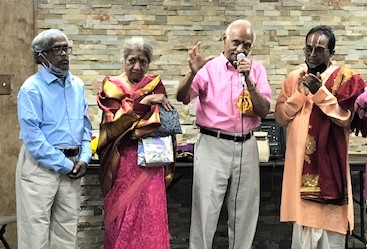
Her background in civil and structural engineering came in handy at various stages of finalizing the plans for the S.V.Temple that was consecrated in 1976. Her volunteer work at the temple continued in various roles in planning many one-of-a-kind festivals and procuring a variety of unique supplies against deadlines from all over the world in the pre-Internet, pre-Amazon, and pre-Walmart days.
Janaki was there to help anyone at any time, whether it was for arranging arangetrams, marriages, and hosting visiting artistes; or helping people in medical and any other type of emergencies. There was no end to the selfless and tireless work she did for all who approached her.
Raghupathi, her husband, on the other hand, is quiet, complementing Janaki’s gregariousness. Often, he introduced himself as Janaki’s husband. He did his master’s in chemical engineering from VJTI, Mumbai and earned his PhD in ChemE from Pitt. After his brief stint at Ford in Detroit, he joined PPG working in various capacities in managing projects. He travelled widely for work, meetings with customers and vendors. He regaled with stories on his visits to Moscow and other cities in the Soviet Union during the collapse of the USSR. He too was associated with the S.V.Temple management in various official capacities.
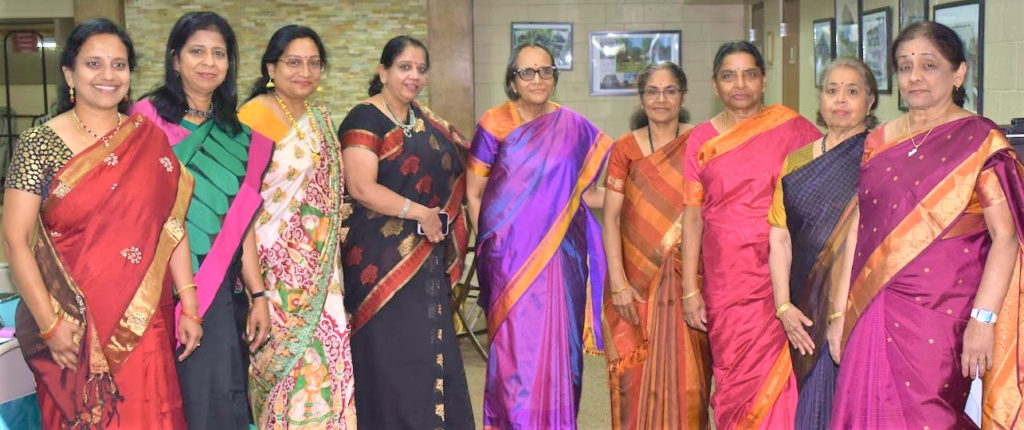
Raghupathi has been the unofficial tax consultant for the priests and office staff at the temple from the time the temple started, making sure that they got all the applicable deductibles and refunds. He also made sure that they also set aside money for their retirement.
The friends of the Raghupathis organized a farewell party at the Murrysville Community Center on July 8, 2022, where they recalled fantastic stories and anecdotes in their interactions with Janaki and Raghupathi. While all their friends miss their presence here, I join them wishing Janaki and Raghupathi well in their retirement with their two children in the sunny San Diego, enjoying their life living close to the beach, the mountains, and the desert. ∎
Opportunities for Middle/High School Children at Civil Air Patrol
Posted by admin in October 2022, Past issues on September 25, 2022
How many of you have heard of the Civil Air Patrol (CAP) and their activities across the nation? Maybe a few. And among school-going children focused on their curricular activities, even less.
Civil Air Patrol, an organization of citizen airmen, was formed in 1941 during the early days of World War II, committed to volunteer services to America. Focused to mobilize the nation’s civilian aviation resources for national defense during WW II, CAP has evolved over the last several decades into a premier public service organization that still carries out emergency service missions, when needed, in the air and on the ground, and much more.
As an auxiliary of the U.S. Air Force, CAP is there to “search for and find the lost, provide comfort in times of disaster and work to keep the homeland safe.” Its tens of thousands of volunteers scattered across the nation devote their time, energy, and expertise toward the well-being of their communities, while promoting aviation-related fields through aerospace/STEM programs and helping shape future leaders through its cadet program.
CAP volunteers serve America’s communities, save lives, and help shape the future with its core values of Integrity, Volunteer Service, Excellence, and Respect. CAP’s programs on Aerospace Education, Cadet Services and Emergency Services, are funded by the US Air Force and the local chapters’ fundraising activities.
In August, I went to a weekly meeting of CAP Squadron 602 held at the Baldwin High School close to the Allegheny County Airport in West Mifflin. The Squadron 602 of CAP is located at the Allegheny County Airport (airport code AGC) in West Mifflin.
Incidentally, AGC, a fully functional airport within the city limits of Pittsburgh, has a long and unique history. Built in 1931, it was the third largest airport in the nation with hard-surface runway, decades before the Pittsburgh International Airport came into being. More details here: www.tinyurl.com/AGC-Airport-Pittsburgh and here: www.flypittsburgh.com/allegheny-county-airport.
The classes at Baldwin High were conducted under the guidance of Major Naor Wallach (e-mail address here) , Pennsylvania Director of Recruiting and Retention of CAP’s Squadron 602. The module they showed was on how they solved the problem when an oxygen tank in the capsule exploded in NASA’s Apollo 13 mission’s near-disaster moon mission. NASA’s ground control folks in Houston struggled against all odds to remotely instruct the astronauts in the orbiter floating 200,000 miles above earth to fix the problem with the very limited resources in the capsule.
The CAP program is open to all middle and high school students who are either US citizens or legal immigrants (Green Card holders) for a nominal fee of $40 per year. A team of over 1500 volunteers, who have their own full-time jobs as USAF staff, railroad consultants, graduate students in universities, and others run the program nationwide.
They meet weekly completing different training modules that focus on developing leadership skills and skills to work in teams (sometimes leading sometimes following), ER services, aerospace/STEM education, physical fitness, and character building. In programs with school kids as the trainees, they use real life examples of how crises unfold — many of them one of a kind happening for the first time. The students are shown examples of how to form teams with the required skills and temperament, how to brainstorm the issues to define the scope, and how to assign priorities and assess progress and performance, and how to make changes in the approach as the situation dynamically changes.
For middle and high school students, programs in the Civil Air Patrol offer great opportunities to acquire skills on how to lead and take part in teams to accomplish any set goals, how to communicate clearly and precisely with peers and seniors in any organization. And the training they get in their formative years may even open opportunities for them in ROTC programs in the US Air Force, commercial flying, Medevac flights, or aeronautical engineering in universities. For more information, visit GoCivilAirPatrol.com or contact Major Naor Wallach (e-mail address here). ∎
Elect Arvind Venkat, MD to the State House
Posted by admin in October 2022, Past issues on September 25, 2022
By Martin Karl and Cathy Poole, Co-Chairs, Franklin Park Democratic Committee
The last few years have been extraordinarily challenging for our families and communities. A once-in-a-century public health crisis, economic challenges, disruption of our kids’ education, threats to school safety, attacks on the very foundations of our democracy, and now, the possibility of ending reproductive rights – the list goes on and on. Our state legislative leaders are critically important to address all these issues. In this election year, the communities of Franklin Park, McCandless, Ohio Township, Kilbuck, Emsworth, Ben Avon, Ben Avon Heights, and Western Hampton Township have the opportunity to elect a capable member from the Indian American community to represent them in the State House in Harrisburg. He is Dr. Arvind Venkat, son of Indian immigrants and the Democratic candidate for the 30th District. He will ensure that we have bold leadership in addressing all these important challenges.
We have gotten to know Arvind over the last six months in his campaign to represent the communities of our district. From the beginning, he has emphasized his background as an emergency room physician with the privilege and responsibility of treating our neighbors in their time of greatest need. Arvind recognizes that just like there is no Republican or Democratic heart attack, we need leaders who will work for all of us, setting aside partisan extremism to solve problems in our community. Having worked on the frontlines of the pandemic, Arvind knows we have under-invested in public health, public safety, and public schools, leaving us vulnerable to the disruptions we have seen. He recognizes that we must fully fund these services to be there for all of us when needed.
Over the last few months, the stakes of this election have only risen. With the US Supreme Court overturning the federal constitutional right to an abortion, the future of women’s reproductive freedom is on the ballot. Similarly, whether we enact commonsense gun safety laws to prevent school shootings and reduce gun violence will be decided in Harrisburg. Finally, whether we continue to nurture our democracy by ensuring that a) every eligible voter has access to the ballot box, and b) our elections, regardless of their outcome, reflect the will of the people, will depend on the members we elect to the General Assembly in Harrisburg.
As a father, husband, emergency physician, member of the Indian American community, and long-time resident of the North Hills, Arvind will be the right representative for us in Harrisburg. He will ensure that our communities are cared for and protected. We are proud to support his candidacy for the State House and urge all voters in our communities to vote for Arvind this fall.On election day this November, vote for Dr. Arvind Venkat.
You can reach out to his team at his website www.VenkatforPA.com. ∎
Why I am Voting for John Fetterman for US Senate
Posted by admin in October 2022, Past issues on September 25, 2022
By Mary Ganguli, Pittsburgh, PA
Editor’s Note: Mary Ganguli lives in the Point Breeze neighborhood of Pittsburgh. She is Professor of Psychiatry, Neurology, and Epidemiology at the University of Pittsburgh School of Medicine and School of Public Health.
I first heard of John Fetterman while he was the Mayor of Braddock, a small Mon Valley municipality, which was once a bustling, vibrant, steel town, but never recovered after the steel industry collapsed in the late 1970s. John is not originally from Braddock; the details of how he, a Harvard graduate in public policy, moved to Braddock make a fascinating read.
John, a Democrat, currently the lieutenant governor of Pennsylvania, is contesting for the open US Senate seat from PA in this November’s mid-term election. Here are his positions (www.johnfetterman.com/issues) on the issues that matter to us as Pennsylvanians.
John became a national media sensation early in his career. This is partly due to his unusual appearance and demeanor — 6’ 8” tall and muscular, a casually dressed, straight-talking man of the people, and not the typical suit-and-tie equivocating politician.
I attended a Pitt Public Health graduation ceremony in 2014 when John was the commencement speaker. His Harvard crimson hood looked like a mere ribbon over the black academic robe draped on his giant frame. He congratulated the graduates, reminding them that they were graduating in the beautiful Carnegie Music Hall built with the steel made in Braddock. He shared the desperate situations of the poorer Braddock families whose homes lacked heating during the winter polar vortex. He then told the graduates to go out and make a difference in the world with their public health degrees — pretty much describing his own career.
I also came to know John personally in 2014 while he was the Mayor of Braddock. I was chasing him down to officiate at our son’s wedding. I had left him notes and voice mail and was wondering how else to reach him. Then, my phone rang and the voice on the other end said, “Mary, this is John Fetterman.” I started to repeat the details I had already put into my earlier messages. He stopped me abruptly, saying. “Mary, this is clearly the first wedding in your family. I have done dozens of weddings. You will have a million things to worry about, and I will not be one of those things. Just tell me when and where to show up, and what you want me to do and say, and I will be there.” And he did. Since then, the Fetterman family has come over to our place for dinner and we found that John has a secret passion for Indian food (gobi mattar is his favorite).
John met with the Indian American community in the Pittsburgh area and with the Indian American organization IMPACT in Philadelphia. John tells me he is proud to receive not only our support but also our input on the issues that matter to us. He is particularly focused on the economy, health, and education, and if elected — only we can make that happen — he hopes to serve on the relevant Senate Committees.
If he is our next Senator, he will show up as promised for us in Washington and do what needs to be done for us Pennsylvanians. So, Let’s get together and Vote for John Fetterman in the November elections. ∎
Every Election is Important — More So This Midterm Election
Posted by admin in October 2022, Past issues on September 25, 2022
Midterm elections draw only highly committed, partisan citizens to polling stations, compared with the quadrennial presidential ones. Voter apathy, particularly among independent voters, is the root cause. These independent voters, if only they go to midterm polls, can change the tone of the political discourse and outcome of elections even in partisan districts.
In both State House and the Senate in Harrisburg for the last three decades Republicans have been in control most of the time. See the table below (source: www.tinyurl.com/PartyinControlofPA-StateHouses):
For the last twelve years, in the General Assembly’s both chambers, the GOP has been in the majority, with a Democrat in the Governor’s office for the last eight years. In 2018, only with a Democratic governor, the state was saved from the GOP-controlled General Assembly gerrymandering the electoral districts to unfairly benefit them, when they redrew the electoral districts. See the article here: www.tinyurl.com/PA-RedistrictedMaps. In this background, this November, three elections are important:
1. For Governor’s office: In the November election, it will be an uphill task for Democrats to gain control of either chamber in the General Assembly in Harrisburg. However, the chances for individual house districts have improved because of the redistricting of the electoral map. So, a Democrat in the Governor’s office is necessary for checking the GOP’s muscle power in both chambers of the General Assembly. Besides, the GOP gubernatorial candidate Doug Mastriano’s extremely conservative position on women’s reproductive rights is troublesome after the Supreme Court overturning Roe v. Wade earlier this year. Democratic gubernatorial candidate Josh Shapiro is moderate on this important issue. We need to elect him as our governor. His veto power will have a moderating influence on the GOP-controlled General Assembly.
2. US Senate: Our Lt Gov. John Fetterman is the Democratic candidate for the US Senate. He is known to our readers as the mayor of Braddock. Mary Ganguli in her article is persuading voters to send Mr. Fetterman to the US Senate. Besides, his GOP opponent, the TV morning show star Dr. Mehmet Oz, appears clueless to the needs of our moderate working class voters’ anxieties and needs.
3. Pennsylvania House District 30: Arvind Venkat, a practicing ER physician, is trying to expand his horizon beyond ER medicine. He wants to represent District 30 in Harrisburg’s House of Representatives as a Democrat. Martin Carl and Kathy Poole are persuading voters in their write-up to vote for Arvind Venkat.
So, on November 8, please go to the polls and discharge your responsibility to do the right thing. ∎
The Difference Between the Old and the New
Posted by admin in July 2022, Past issues on July 7, 2022
From time immemorial in India, rivers have been used as a metaphor. Examples: Hinayanam (literally the Small Vehicle or Boat) and Mahayanam (Big Vehicle or Boat) in Buddhism, samsara sarovar (the sea of life), and teerthankaras (the Boatmen Who Help to Cross the River) are the Jain masters.
We have rivers all over India that people need to to cross over for going from anywhere to everywhere.
No wonder, Urdu poets too have used rivers and boats as metaphors in simple-sounding shers (two liners). Here is one by Akbar Allahabadi (1846-1921) that Harish Saluja sent me sometime back, also providing me with its translation:
The difference between old light and the new light is only this:
One can’t find the boat; the other can’t find the shore.
In Indian languages, there is more to any two-liner doha of shayiri than its literal translation. The light the poet talks about is insight. The “Old” has the insight to see the shore afar, but not the resources or the strength to reach there. And the “New” has the resources and strength, but does not know where the shore is. This is the ultimate paradox of life.
Bus Driver’s Error Takes Kerala Pilgrims to the Goa Beach 300 Kilometers Away
Posted by admin in July 2022, Past issues on July 7, 2022
Kerala could be the state with the highest literacy rate and better social indicators in the aggregate. But aggregate numbers do not tell about individuals as this story shows.
In May 2022, the Kerala State Transport Corporation introduced an air-conditioned sleeper bus service from its capital Tiruvananthapuram to Kolluru Mookambika temple, the famous Devi temple and pilgrimage destination for Keralites, north of Mangaluru in Karnataka. On the inaugural trip, on the coastal highway, late at night, the driver missed the exit to Mookambika temple and continued straight, not recognizing that he missed the exit.
Passengers deep asleep in the bus were expecting to be at the Mookambika temple at dawn. When the passengers opened their eyes in the morning, they found themselves on the beach in Goa, 300 kilometers away from Kolluru, seeing scantily clad gora men and women tourists playing beach volleyball. The driver blamed Google map for wrong directions. ∎
A Letter to the Editor
Dear Editor:
Enjoyed the last page article Wicked Tamil Nadu Humor in the April issue. Similar things happens here in the USA too, right here in our own neck of the woods. Across from my housing plan on Beaver Grade Road, in Moon Township our Port Authority contractor built this bus stop.
The bus route on my street was never active and I never saw a single bus on this road. Finally the Port Authority officially discontinued the route as uneconomical on account of the lack of riders.
However, after the bus stop was installed, contracts were awarded for ad hoarding. Maybe the contractor rushed to finish the job before he got notification of the cancellation!
Currently, even with no bus plying on this road, every every few months the advertising contractor comes and replaces the poster! — Mahendra Shah, Moon Township, PA ∎
The Reptilian Brain on Hyperdrive
Posted by admin in July 2022, Past issues on July 7, 2022
Arun D. Jatkar, Monroeville, PA
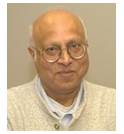
When my wife and I arrived in the US in 1973, we lived in Salt Lake City, Utah. I was a graduate student at the University of Utah and my wife Shobha was a graduate student at Brigham Young University. A Mormon land through and through. I could write many anecdotes about our experiences while we pursued our PhD degrees, but recent events in the body politic of the USA take my mind elsewhere.
During our four years of living in Salt Lake City, we watched with awe and wonder the narrowly missed impeachment of President Nixon. Such a thing was so much against the very grain of our cultivated reverence for Prime Ministers, Presidents, and many other past and present figures of national importance. It taught us what democracy is all about and we said to ourselves, “If only Indians stopped chanting ‘Indira is India and India is Indira!’”
The year 1976 was the 200th anniversary of the Declaration of Independence of the American colonies from England. We were bombarded by the conviction deeply rooted in the American psyche that “the American Constitution is divinely inspired.” In India, the only divinely inspired words are the four Vedas. It was also the time that the ERA (Equal Rights Amendment) was on its way to being ratified in several states of the USA.
Move forward to 2022. Despite the abundantly proven fact that there is not a grain of truth in ex-President Donald Trump’s irrational and evil claim that the 2020 election was stolen from him, he and his allies in the House and the Senate in Congress are unfailingly bent upon bombarding the whole country with that Goebbels-style lie (Goebbels was Hitler’s Minister of Propaganda, whose mantra was, “A lie told once remains a lie, but a lie told a thousand times becomes the truth”.) With the ex-President’s continued hold on a vast cross section of Republican voters, the “divinely inspired” constitution is increasingly becoming a sorry victim.
When I look at all this, it makes me think that a nation may land a man on the moon and a robotic explorer on Mars; but its primitive reptilian brain simply refuses to become sophisticated. And right now, that reptilian brain is on hyperdrive! ∎
The landmark Roe v. Wade decision of the Supreme Court of the United States in 1973 had remained unshaken until now. But it did not survive the majority opinion of the current Supreme Court. As if that was not cruel and evil enough (see the lead article by Premlata Venkataraman), one of the six justices who ruled to overturn the Roe v. Wade landmark decision of 1973 has further suggested that the Supreme Court should also reconsider several constitutional rights!
Obituary: Mani Balu (1935 – March 28, 2022) Soft-Speaking Pediatrician, Helpful & Caring
Posted by admin in July 2022, Past issues on July 7, 2022
By Sudha Dixit, Wexford, PA
Sudha Dixit, a long-time friend of Mani Balu, lived in Uniontown before she and her husband moved to Wexford. With her husband Niranjan practicing medicine, Sudha lived in Uniontown for decades as Mani Balu’s neighbors.
Dr. Mani Balu, a long-time resident of our area who practiced pediatrics in Uniontown for several decades, suffered a cardiac arrest on March 28, 2022, and passed away even before the emergency medical staff arrived. He was 87.
Mani Balu was the youngest of six siblings, born in 1935 in Thoothukkudi in Tamil Nadu. Mani completed his medical degree at Kilpauk Medical College in the late 1950’s. He was posted as a civil assistant surgeon for Tamil Nadu in various small towns. He married Shantha in 1961. They had two children, Ravi, and Latha, while in India. The Balus came to the United States in 1968, with Mani wanting to train in pediatrics. He studied pediatric endocrinology in New York’s Queens General and Long Island Jewish hospitals. After completing training, the Balus moved to Big Stone Gap, Virginia. Later, in 1993 they moved to Uniontown, PA, with Mani joining Dr.Thomas D’Auria to practice pediatrics. After Dr. D’Auria’s retirement, Balu continued and expanded the practice in Uniontown, with three pediatricians joining him.
Dr.Mani Balu retired from his practice in Uniontown in 2015 and moved to Monroeville to be close to their son, Ravi Balu. In his retirement, Mani Balu annually went to Chennai and spent several weeks in Chengalpattu, treating leprosy patients. With Shantha’s dedicated support, he silently continued his philanthropic work there from his own resources, be it for leprosy relief efforts or funding education for young girls and underprivileged children.
Balu was an avid reader of the classics and Hitchcock. He was an ardent fan of Raj Kapoor songs and cricket. With his friends practicing medicine in Uniontown, Balu would watch cricket matches and travel to many places. Personally for me, Balu was my Pediatric Help Hotline while we were helping our daughter raise her two children. Mani Balu was known for his humility, generosity, compassion, and openness towards his friends. The Balus bore their painful personal losses with stoicism, fortitude, and resignation.
Dr. Mani Balu leaves behind his wife Shantha, and his son Ravi Balu, his daughter-in-law Raji, his two grandchildren, and a large number of his friends. Mani Balu was cremated on March 29, with Pandit Gopala Bhattar helping Dr. Balu’s son, Ravi, with the Vedic cremation rites. Dr. Mani Balu’s family organized a memorial service in Monroeville in early April with a number of his friends in attendance. ∎
From the Kolis (कोळी) to The Wholey’s — A Seafood Story
Posted by admin in July 2022, Past issues on July 6, 2022
By Deepak Kotwal, Squirrel Hill, PA
In early June, Deepak Kotwal, a Maharashtra native and a seafood connoisseur, visited Wholey’s in the Strip District to write about their business and how they cater to the seafood lovers in our area. Note: The Kolis (कोळी) are the Marathi fishing community that dominates seafood harvesting and trading in Maharashtra.
When Indians first settled in the Pittsburgh area in the 1960s, pescatarian Indian immigrants from Mumbai and coastal regions of Maharashtra savoring paplet (pomfret,) bombeel (Bombay-duck) and surmai (kingfish), and the macher-jhol-loving Bengalis, whose favorites are hilsa and rohu, and from all over the peninsular and other regions of India were thrilled to “discover” Wholey’s in the Strip District. They are the largest seafood retailer in Southwest Pennsylvania. Local supermarkets then did not have much of a seafood section. Until fish-loving Indians in and around Pittsburgh found out about Wholey’s, their options were frozen fish sticks and canned tuna to whet their cravings for seafood.
The word Koli (कोळी) in Marathi refers to the traditional Marathi fishermen community that dominates the seafood harvesting and trading business in Maharashtra. My childhood memories include shopping for fish and price-haggling, mostly unsuccessfully, with the kolanīs (कोळणी), the kolī women who managed the retail sales. Their men were on the seas harvesting their catches or getting ready for their next fishing expedition. My daughters’ childhood memories here include going to Wholey’s and holding a slippery smelt in each hand.
Besides ethnic identity, religion, language and clothing, food is an important marker of one’s cultural identity. The late Anthony Bourdain, the famed chef, author, and TV culinary travel host, showed through his TV shows, how to understand cultures through their food.
Here in the US, a land of immigrants, by necessity, new arrivals quickly adapt to the morés of the land to blend in. They switch to local clothing. Their children lose proficiency in their mother tongues in one or two generations. But they continue their culinary traditions passing them on to their children. Childhood food and taste memory is a powerful force.
There is a perception outside India that most Indians are vegetarians. But with its 7,000-plus kilometer coastlines and 400-plus rivers with over 12,000 miles of rivers and countless ponds and lakes, it is natural that seafood is a major part of the Indian diet. There are many references in old Sanskrit and Tamil literature to all types of fish and other aquatic creatures and fishermen communities. In 2000-plus year-old Tamil classics, neithal (ெநய்தல்) is the term for seashores, having unique landscape features, human settlement and activities. Here is a website listing the Indian names for a variety of different fish types: www.tinyurl.com/Fish-names-in-Indian-Languages As an aside, in India, Bengali brahmins and Saraswat brahmins in Maharashtra are seafood connoisseurs. Why some brahmins are vegetarians and others are not is a topic for another article.
Recently, I visited Wholey’s in the Strip District to inform readers of a whole range of seafood items at the store. I spoke to John McNally, a purchasing and marketing veteran with Wholey’s, and Muriel Maze, who joined the Wholey’s recently, to learn more.
In 1912, Robert L. Wholey, from an Irish immigrant family in McKees Rocks started a food distribution company dealing with poultry, meats, sausages, and coffee. His son Robert C. Wholey in 1948, after returning from his military service in WW-II, started a live chicken store in what was then known as “Diamond Market” in downtown Pittsburgh.
In 1959, the Diamond Market was converted to the current up-scale Market Square, forcing their poultry and meat-related business to move to the Strip District. It was a difficult business decision since theirs would be the first retail food store among all the wholesale shops there. It is a truism that successful businesspeople listen to their customers. Around 1960, a customer who had gone to the Chesapeake Bay area came to Mr. Robert Wholey with a large catch of crabs and asked whether the Wholey’s would put them up for sale in his store; they did. Sensing an opportunity, Wholey’s added a fresh seafood section. The rest, as they say, is history. Today, Wholey’s sources their seafood from all over the world. They even have a cooked food section as well, the most popular item being their fish sandwich.
The Wholey’s has a significant customer base from among the people of Indian origin living in this metro area. John explained that Indian customers like to buy the whole fish and have it cleaned by the store’s skilled staff. Fish cleaning requires special skills and there is in-store training for the job, which commands better pay, and has a much lower turnover rate. We chatted with Mr. Yum Duong, a fish cleaning specialist with the Wholey’s for over 20 years, an immigrant from Vietnam. He is well tuned into how to prepare fish steaks, bone-in, for the Indian market.
The fish types popular among Indians are bronzini, blue fish, sea bass and catfish among others. Also popular are butterfish, a small fish that is cooked whole. Pompano and flounder remind us of paaplet (pomfret.)
The local American population sticks to boneless fillets, as most do not know how to cook and eat a whole bone-in fish. Indian immigrants who learnt to eat fish in India know that bone-in fish preparations are tastier than boneless fillets.
Raw shrimp sold at Wholey’s, as in most of America, is head-off (that is, with its head cut off). Most of the shrimp’s fat is in its head. So, when the shrimp has its head on, it tends to become mushy. Headless shrimp can retain their original crispness and texture because of the absence of fat and is preferred by Americans.
In the late 1970’s, a few fish-eating friends of ours would order head-on whole shrimp from Louisiana. We woulde pick up the 50-lbs dry-ice-packed Styrofoam box at the airport, and split the huge shipment. For a true fish-lover from India there is nothing more delectable than sucking on a curried shrimp head! I know, I know, some of you, who are used to eat shrimp the American way are probably repulsed by this. But then, food, like beer, you will agree, is an acquired taste!
When I buy a whole flounder at Wholey’s and have it cleaned at the store, I always request the cleaner to check for egg sacks inside. These egg sacks are an Indian delicacy, but routinely thrown out here.
There are those Indian immigrants who were vegetarians back home and have switched to eating fish after coming here. They learnt to eat fish in restaurants, always served as boneless fillets. These Indians generally do not like whole fish prepared bone-in and with Indian curries and spices.
Climate change, increased world demand for seafood and improvements in the mechanized fish harvesting technology have led to overfishing. While per-capita meat consumption shows a downward trend in the developed countries for health reasons, seafood consumption has increased. Naturally, some species are near extinction. Fish-farming may be the savior of some of these species. Given the increased demand for seafood, flagrant violations of international agreements to limit catches are common. The Marine Sustainability Council (MSC) and the National Oceanic and Atmospheric Administration (NOAA) are working to promote sustainable practices. Whole Foods uses a red/yellow/green rating of MSC. John McNally at Wholey’s assured me that their policy is to sell only sustainable species. It is incumbent on all pescatarians to ensure that the seafood they consume meet the level of sustainability.
The fish-loving Indian immigrant community here and Wholey’s have a symbiotic relationship: the former wanting to fulfill their desi cravings of seafood, and the latter, wanting to find a new market segment for expanding their business. The Wholey’s in the Strip District ensures that despite Pittsburgh not being on either coast of this vast country, it is not a gastronomic wasteland in the sphere of seafood delectables. ∎
Juginder and Dolly Luthra, Well-Known to Patrika Readers, are Moving to New Jersey
Posted by admin in July 2022, Past issues on July 6, 2022
By Kollengode S. and Prema Venkataraman
Juginder and Dolly Luthra, long-time residents of Weirton, WV and well-known to Patrika readers and the Indian diaspora here, are moving to New Jersey, to be close to their daughters and grandkids, in their retirement. This is a trend among Indians in their autumn years.
“There is a pang of sadness in leaving the community,” said Dolly Luthra wistfully, continuing “even as we are happy to look forward to spending more time with our grandkids.”
They raised their daughters and took part in social and cultural events around the city, as is usual in Indian communities everywhere. Soon they went beyond just participation. Living in Weirton close to the Greater Pittsburgh Indian diaspora, they were the patrons supporting Indian classical traditions of music, dance and performing arts.
Dolly recalled arriving in Pittsburgh over four decades ago with their 6-week-old twin daughters in a bassinet and another 4-year-old daughter in tow. They settled in Weirton WV to start their practice in healthcare — Juginder in ophthalmology and Dolly in dentistry.
Weirton in its heydays of the Mighty Steel starting in the early 20th century, attracted immigrants from all over Europe to run the thriving steel industry. The city organized an annual Festival of Nations in Spring to highlight the culture of the many immigrants. But this festival ended in 1948, after the end of WW II.
When Weirton revived the Festival of Nations in 2009, Juginder introduced Indian folk and classical dances in the festival to highlight the new immigrants from India settling in Weirton. He dipped into the resources available in Pittsburgh and enriched the Festival of Nations to include many dance traditions from Asia. Nandini Mandal wrote a story on this. (www.tinyurl.com/Luthras-Story-by-Mandal)
Both Dolly and Juginder are also well known for their artistic talents outside the narrow confines of their professions. Dolly acted in dramas. Juginder was the main lead in a 15-minute short movie titled Sunflower about getting old, directed by Ferris Rosati. Many of Juginder’s friends would recall his singing ghazal/shairis and other genres of Hindi songs.
The Luthras coauthored poems in the Pittsburgh Patrika. Juginder also authored poignant articles in the Patrika on his childhood as a Partition Child, when Juginder’s parents moved to India with their young kids leaving everything they had in Pakistan.
When we approached the Luthras to feature a story on Saroj Bahl, and her efforts to set up the India Nationality Room at the Cathedral of Learning in Oakland., they readily responded to our request. The Luthras talked extensively to Saroj and her husband Mohinder Bahl on this topic. Their fascinating account of how the Nationality Room came into being culminated in an article in the Patrika in 2009.
Similarly, they talked to Nandini Mandal in 2018 on her journey in Indian dance traditions through her challenging health situations (www.tinyurl.com/Luthras-on-NandiniMandal).
Making their marks in their professions and giving back to their communities (Weirton and Pittsburgh), while sharing their love of literature and the performing arts, Dolly and Juginder enriched the lives of people in our area that they called home for four decades.
We are sure they will be active on matters that interest them in New Jersey as well. Surely, we expect and anticipate that they will continue to use the Patrika as a platform for sharing with readers their poems and essays in the coming months and years. Please join us in wishing the Luthras good health and happiness in their new place, spending their times with their daughters and grandkids. ∎
Maestro Zakir Hussain’s Electrifying Tabla Recital Came Once Again to Pittsburgh
Posted by admin in July 2022, Past issues on July 6, 2022
By Nicholas J. Gigante, Vice President of Development Pittsburgh Cultural Trust, Pittsburgh, PA
Finally, Covid-related restrictions were receding further in our rear-view mirror, and we were in spring last April. In a wonderful sign that downtown Pittsburgh’s Cultural District is returning to life once again, the Pittsburgh Cultural Trust presented a return engagement of the Tabla Maestro Zakir Hussain in Triveni at the Byham Theater on April 12. Nearly 1,000 patrons came to the recital on a Tuesday and thoroughly enjoyed the performance by Mr. Hussain, the tabla superstar, performing along with Kala Ramnath on the violin and Jayanthi Kumaresh on the veena.
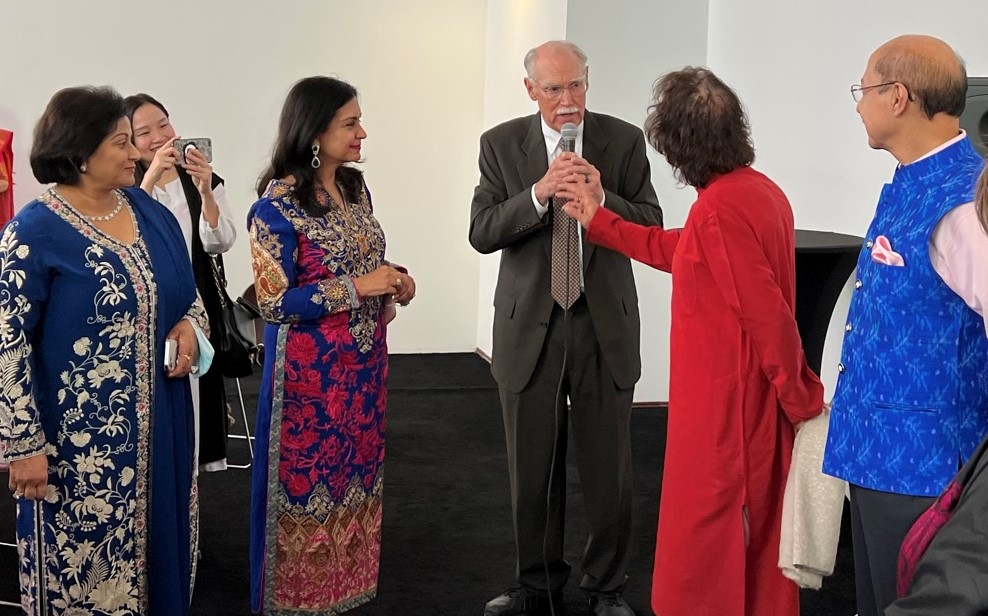
Prior to the evening recital, around fifty guests attended a special meet-&-greet with the dynamic and engaging Mr. Hussain, along with Ms. Ramnath and Ms. Kumaresh. Mrs.Nita and Mr. Sunil Wadhwani, well-known to the readers, hosted the reception in the Byham Theater’s Fulton Mini lounge, overlooking the Allegheny River. Mr. Hussain and his musical colleagues interacted with guests, posed for pictures and selfies, and signed autographs.
Mrs. Wadhwani, along with Cultural Trust President and CEO, Kevin McMahon, made remarks jubilantly welcoming Mr. Hussain back to Pittsburgh. Mr. Hussain also delivered heartfelt musings highlighting his excitement to once again be performing for live audiences, especially his devoted and enthusiastic fans.
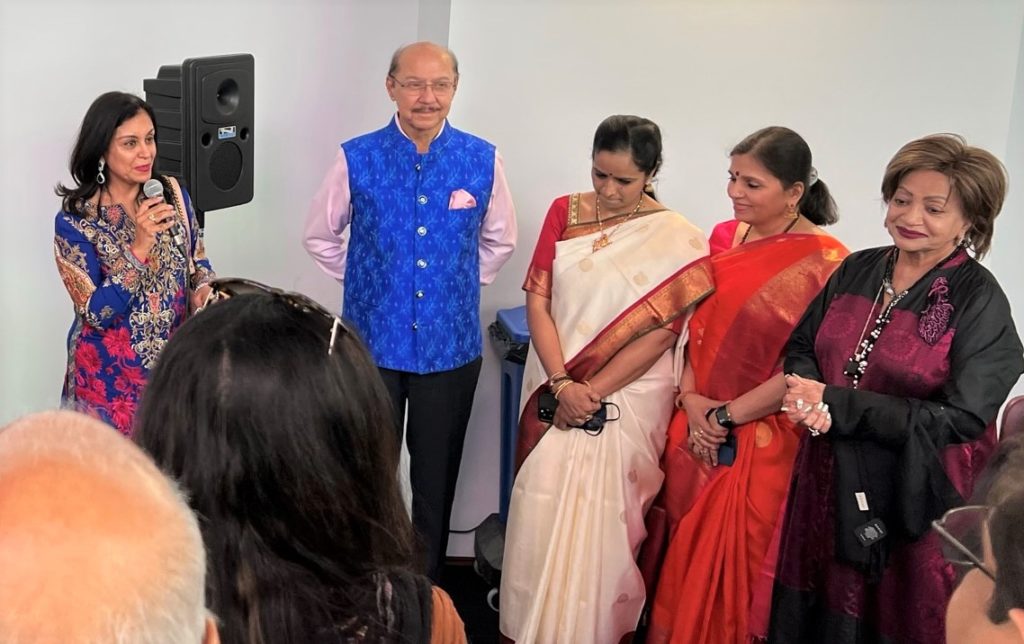
Mrs. Wadhwani is a member of the Pittsburgh Cultural Trust’s Programming Committee. Her husband, Sunil, is on the PittsburghTrust’s Board of Trustees. Also in attendance, among others, was fellow Cultural Trust Trustee, Sarika Goulatia, along with her husband, Dr. Amit Goulatia. ∎
The Regressive Reversal of Roe v. Wade
Posted by admin in July 2022, Past issues on July 6, 2022
Finally, on June 24, 2022, the Supreme Court overturned Roe v. Wade by a vote of 6-3. The 1973 Roe v. Wade ruling was given, interpreting that the “Due Process Clause” of the Fourteenth Amendment to the Constitution gives a fundamental “right to privacy” protecting a woman’s right to opt for terminating her pregnancy (aka abortion). The overturning of the 1973 decision was expected for weeks — social media was abuzz that it would be struck down, and the death watch was already in place.
This latest overturning of the 1973 ruling will cause a tectonic shift in all these rights and even beyond. The 1973 Roe v. Wade decision went beyond abortion: it included the right to contraception as well. Many states in the South, where social and religious conservatives run the government machinery, had already started imposing restrictions on abortion.
Striking down Roe v. Wade has always been in the campaign promises of many Republican presidential and congressional candidates in elections. But it gained momentum during the Reagan presidential campaign in 1980. It was ironic that the B-grade Hollywood actor, Ronald Reagan, in the 1980s, made this a campaign promise when running against Jimmy Carter, an Evangelical Christian, to woo the religious conservatives led by the Rev. Jerry Falwell. And Reagan struck gold!!
Ever since, every Republican presidential candidate has promised to appoint judges to the Supreme Court to strike down Roe v. Wade to appeal to social/religious conservative voters. Of course, the maverick Republican Donald Trump appointing three justices to the Supreme Court made this easy. Nobody will miss the irony that the thrice-married Trump, a playboy with a promiscuous, unrestrained, philandering — you pick the adjective — lifestyle throughout his adult life, made this happen! Predictably Trump took credit for the decision, keeping the 2024 presidential elections in mind: “Today’s decision, which is the biggest win for life in a generation … was made possible because I delivered everything as promised.”
Americans have always been divided on the issue of abortion. Those opposed to women’s need to have the options on reproductive matters prophesied that rates of abortion will rise and promiscuity among teenagers would lead to more pregnancies. Much to their chagrin, this did not happen (see the graphs). On the contrary, better sex education and dissemination of correct information resulted in fewer teenage pregnancies.
Similarly, as working women focused on their careers, the birth rate too declined. The blame for this is the abysmal state of paid maternity/paternity benefits and the prohibitive cost of childcare for working class families.
Some states rushed to ban abortions altogether (the count is now seventeen) and many more will join them in the coming months. Now, in many of these states, abortions will be accessible only to those women with money to travel to states where abortion is still available, who have the resources to pay for the service and stay in hotels, costs that may run into a few thousand dollars. But abortion numbers are closely tied to the poverty level of women. See the table below:
Low-income rural and urban women of all ethnicities in the American context, who cannot afford to pay for the abortion, are the biggest victims of the US Supreme Court decision. These women, already burdened with low wages and higher unemployment with less access to medical facilities, will be victimized for this over-reach of the Supreme Court.
In the post-feminist era, a new generation of women took the victories of the feminist movement for granted. With better access to education and better paying jobs, many felt complacent about the freedoms they enjoyed. They will have to start the struggle all over again to gain control of their reproductive rights. Now, there will be a new respect for the earlier feminists who fought and won concessions to gain control of their reproductive rights — from sex education/contraception to abortion.
So, where are we headed from here? For starters, restrictions to abortion in many states are likely to increase the serious complications for women and infants during childbirth. Further, where abortion is not legally available, outcomes for medically high-risk births will result in dangerous situations, mostly for low-income, less educated women. This should be of grave concern for public health administrators, irrespective of their ideology on women’s reproductive rights.
Fixing this problem requires a long-term outlook. Electing more women who are pro-choice — not just in Congress, but also in state and local government — is necessary to bring women’s issues into public focus. Not just reproductive rights, but paid maternity/paternity leave, and helping families with childcare costs.
What should young parents do now? It is important now more than ever that parents with young children take on the important duty of educating their daughters and sons as well — and particularly sons, one might say — on their personal responsibilities in their interactions with their peers of the opposite gender. Discussing openly and freely in the home in one-on-one discussions and in schools is imperative for saving our children from the horrible consequences of pregnancies when they are themselves children.
This regressive decision by six judges of the Supreme Court, prompted solely by their partisan politics and conservative ideology, is deplorable to say the least. Deplorable because this decision
a) reverts an already settled issue,
b) is intrusive in our cherished right to privacy,
c) completely ignores the widely available socioeconomic statistics of unwanted pregnancies that are cruel to the working class and poor disadvanged women of all races and color, and
d) overlooks the advances in medicine in detecting serious fetal defects resulting in a huge burden on all women, families, the healthcare system, and taxpayers when women are forced to carry to terms their high-risk pregnancies. ∎
British Airways Revives Its Nonstop to London Heathrow from Pittsburgh
Posted by admin in April 2022, Past issues on April 14, 2022
British Airways resumes its nonstop services to London Heathrow starting in June, four days a week. On Tuesdays, Wednesdays, Fridays and Sundays the flight departs from London Heathrow at 4:45 p.m. and lands in Pittsburgh at 7:50 p.m. The return flight will depart Pittsburgh the same day at 9:50 p.m., arriving in London at 10:10 a.m. the following day
.British Airways started the service to Pittsburgh in 2019. The flight operated successfully for a year before Covid-related travel restrictions led to the flight’s suspension in 2020.
The flight is expected to generate more than $50 million annually to the Pittsburgh regional economy. For people traveling to the Indian subcontinent, this convenient flight offers several options to reach many big cities with one stopover in London Heathrow, and all second-tier cities via Dubai, Abu Dhabi. Qatar, or through Mumbai and New Delhi. ∎

